Gravel bikes are a hype and very trendy. But not all gravel bikes are equal! So, how do you navigate the jungle of different models, constant new releases and special offers to find the bike that suits your personal riding style best? Our detailed gravel bike buyer’s guide is here to take a load off and help you decide which bike to buy.
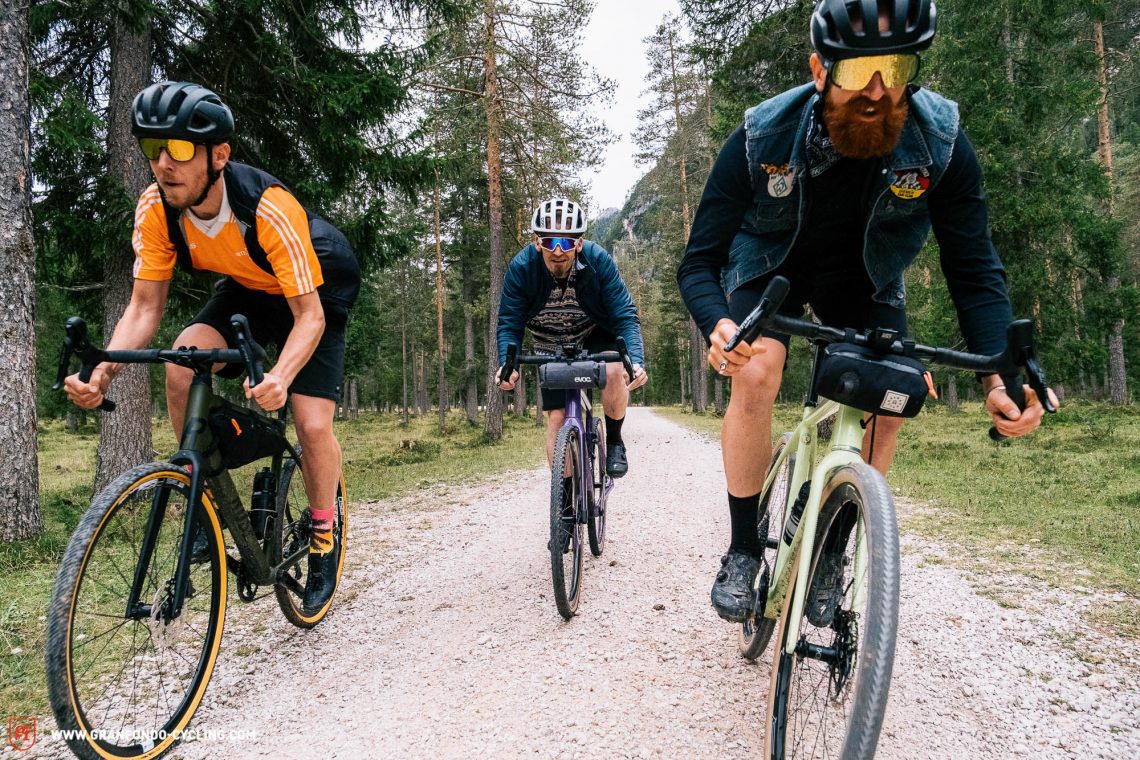
Table of content
- What is a gravel bike? Mere hype or a sensible investment?
- Which gravel bike is right for me, or rather, which type of graveler am I?
- Hype is our religion – the trendy gravel bike
- Gravel bike vs cyclocross
- Is an E-gravel bike the right bike for you
- What does a good gravel bike cost?
- Where can I find the latest gravel bikes? Which is the best gravel bike of 2021?
- The most important tips for buying a gravel bike
- Should you buy your gravel bike online or from a local retailer?
- Do we recommend used gravel bikes?
- The 0% financing option from bike dealers or brands
- Rent instead of buy – the gravel bike subscription
- What are the follow-up or maintenance costs of a gravel bike?
- Which pedals are the right choice for your gravel bike?
- Tube or sealant – Does going tubeless make sense on a gravel bike?
- What wheel size and tire concepts are there for the gravel bike?
- What is the perfect gravel bike drivetrain? 1x, 2x, mechanical or electronic?
- Frame materials – Heavy metal or CFRP?
- What is the best material for a gravel fork?
- The best brakes for a gravel bike
- Gravel bike seatposts – Classic, suspended or a dropper?
- Gravel bike suspension forks
- Gear and accessories for your gravel bike
- Riding kit for your gravel bike
Introduction
Gravel bikes are more present than ever, whether in your local woods, in bicycle brands’ portfolios or on the website of your favourite online bike magazine. With this boom, the choice of gravel bikes has grown exponentially. Gravel bikes don’t have to conform to fixed definitions or standards, giving brands a lot of freedom to play with their designs and builds. Many have developed their own, unique interpretation of an all-terrain bike with drop handlebars, making for an incredibly colourful and diverse market. Of course, this may seem enriching at first but it presents you with a considerable challenge when buying a gravel bike. To help you avoid the frustration of buying the wrong bike and instead make a smart investment in the perfect bike for you, this buyer’s guide summarises all the important points to keep in mind when buying a gravel bike. But don’t worry, we’re not going to talk you into buying anything! Our aim is to give you an overview of all the relevant facts so that you can then make the best decision to buy or not to buy. Take your time to read our guide, it’ll be worth your while! Ideally, the time invested here will not only make you look forward to your new bike even more, but it should also lead to you finding the perfect gravel bike and a lot of happy memories. Let’s go!
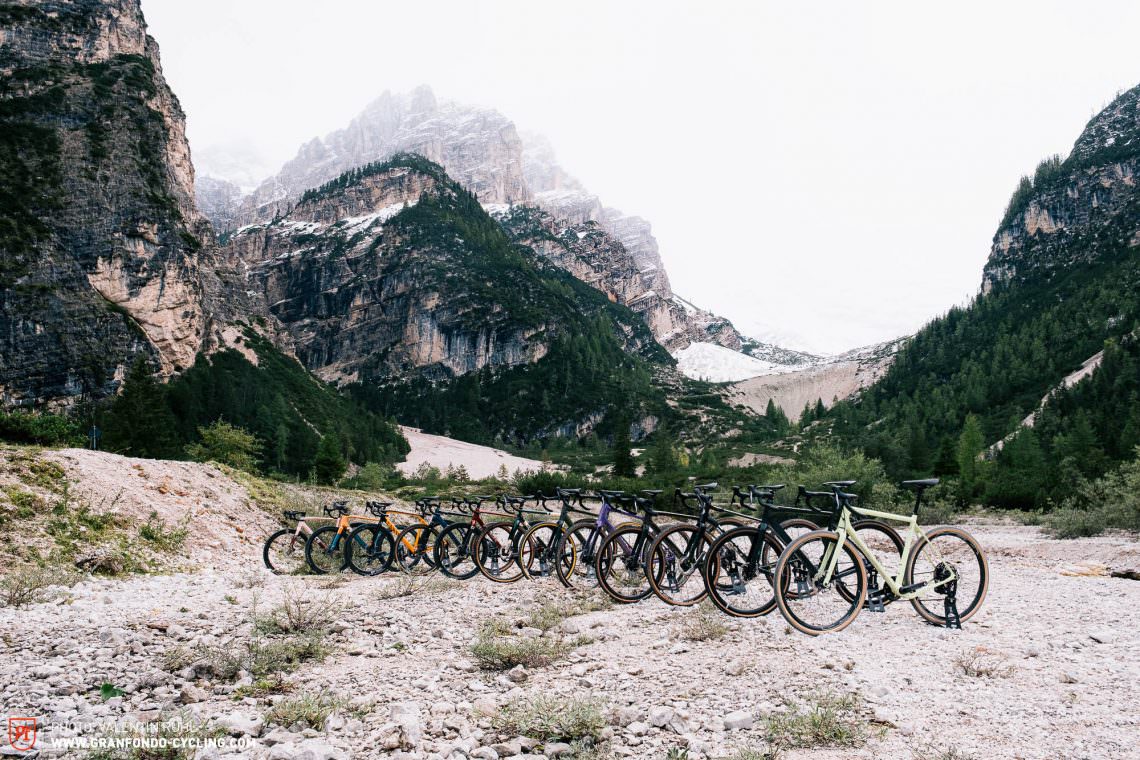
What is a gravel bike? Mere hype or a sensible investment?
A gravel bike can be classified as the point where road and mountain bikes meet – the best of both worlds. It is light, fast and efficient on compact surfaces but still composed and stable enough to tackle moderate off-road terrain. Versatility is key! Go anywhere, do anything. A gravel bike isn’t just a road bike with off-road tires. The geometry and thus the riding position is less about being as aggressive and efficient as possible, focusing more on long-distance comfort and stability instead. For most gravel riders, the point is experiencing the outdoors and enjoying the scenery, cycling without traffic jams and dangerous roads, away from all the honking and cars overtaking with just centimetres to spare.
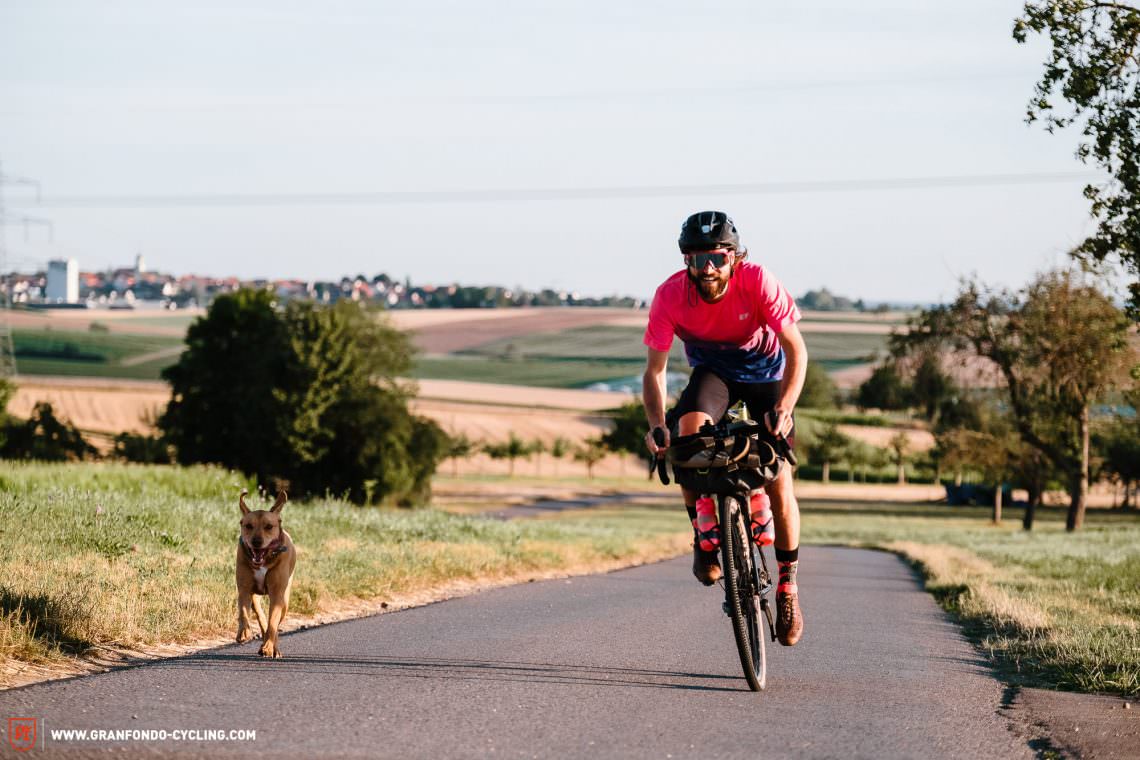
However, the more competitive among us also get their money’s worth. Numerous gravel-specific events and races are now well-established, differing significantly in character to include everything from the more relaxed atmosphere of Grinduro (read article) to highly competitive events like Unbound Gravel (formerly Dirty Kanza). Accordingly, you won’t only find gravel bikes with wide and comfortable 700 x 40C or 650 x 40B tires, such as the Salsa Cutthroat GRX 600 (read review). You also get bikes tuned for speed with narrower 700 x 35C tires, such as the 3T Exploro Race (click for review). In general, they have one big advantage: gravel bikes are incredibly versatile, allowing you to use them however you please, not restricting you nearly as much as you would be on an aero road bike or a downhill mountain bike. Often, all you need is a second set of wheels to allow you to use the bike for different disciplines, even as a road bike with slicks unless you’re totally hung up on maximum performance. It’s a beautiful thing!
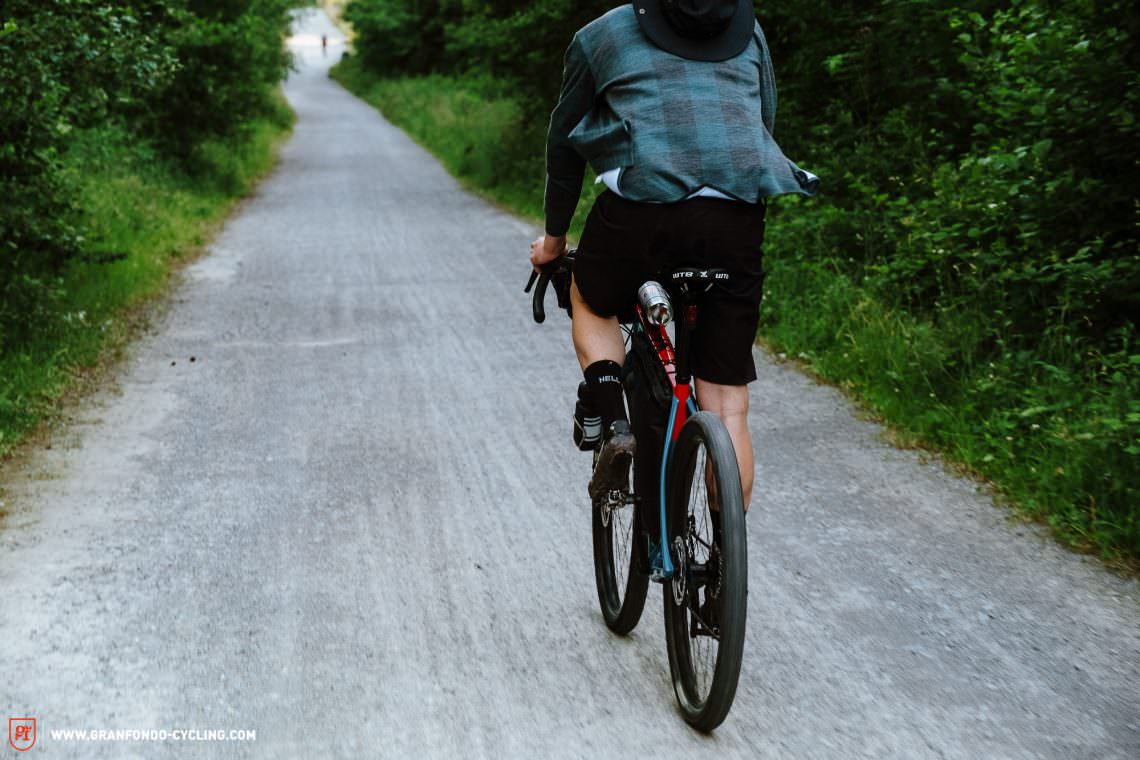
Which gravel bike is right for me, or, which type of graveller am I?
First of all, you have to ask yourself where you’re planning to ride. What type of rider are you, which bikes do you already own and where else do you ride with your bike? Even though, in theory, you could do anything aboard a gravel bike, some bikes perform particularly well in situation X and others that perform better on category Y routes.
We’ve divided the gravel bike market into nine categories, explaining their requirements and giving you an example of a few bikes for each.
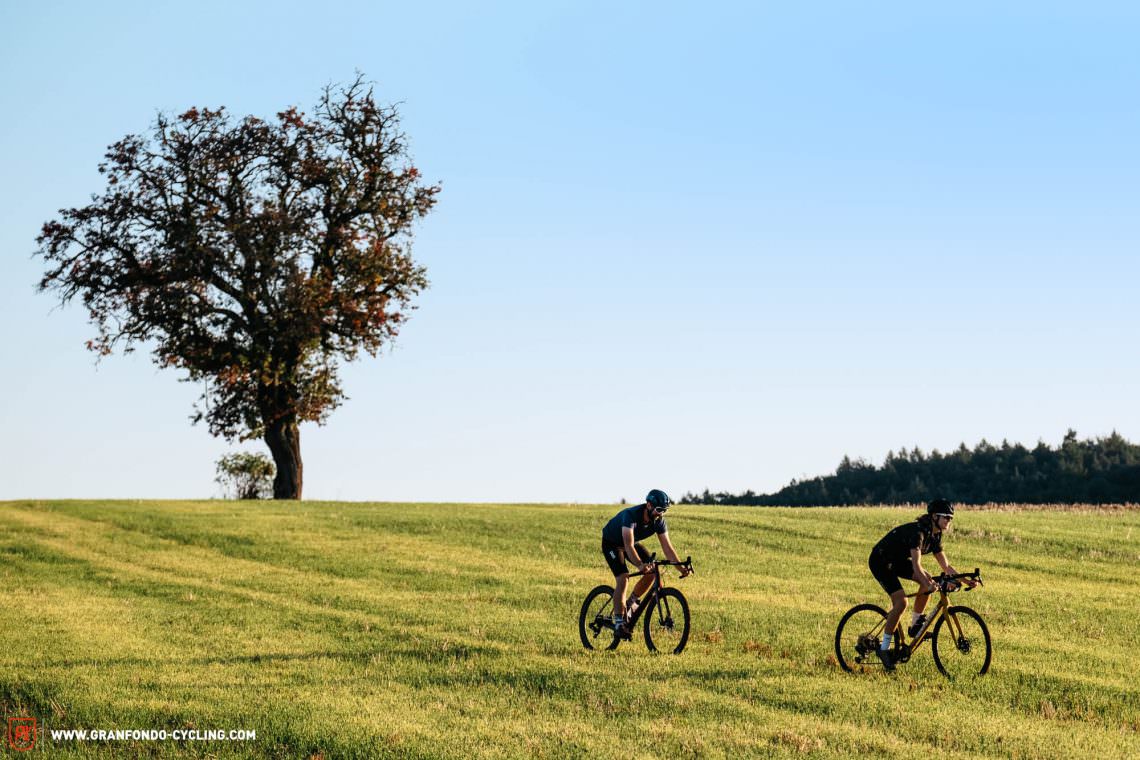
Local recreation – Enjoying the outdoors
Regardless of whether it’s a quick trip to the local pub, to the closest lake or on a bike path along the Danube, gravel bikes are typically used for relaxed rides on gravel roads, quiet tarred roads and woodland paths. The bike shouldn’t shy away from family rides with the kids either, without bringing out your competitive side when you’re on the home straight. It’s all about enjoying the ride and stopping frequently for a glass of beer or wine, so you shouldn’t be wearing your white kit in case of a spill. 😉
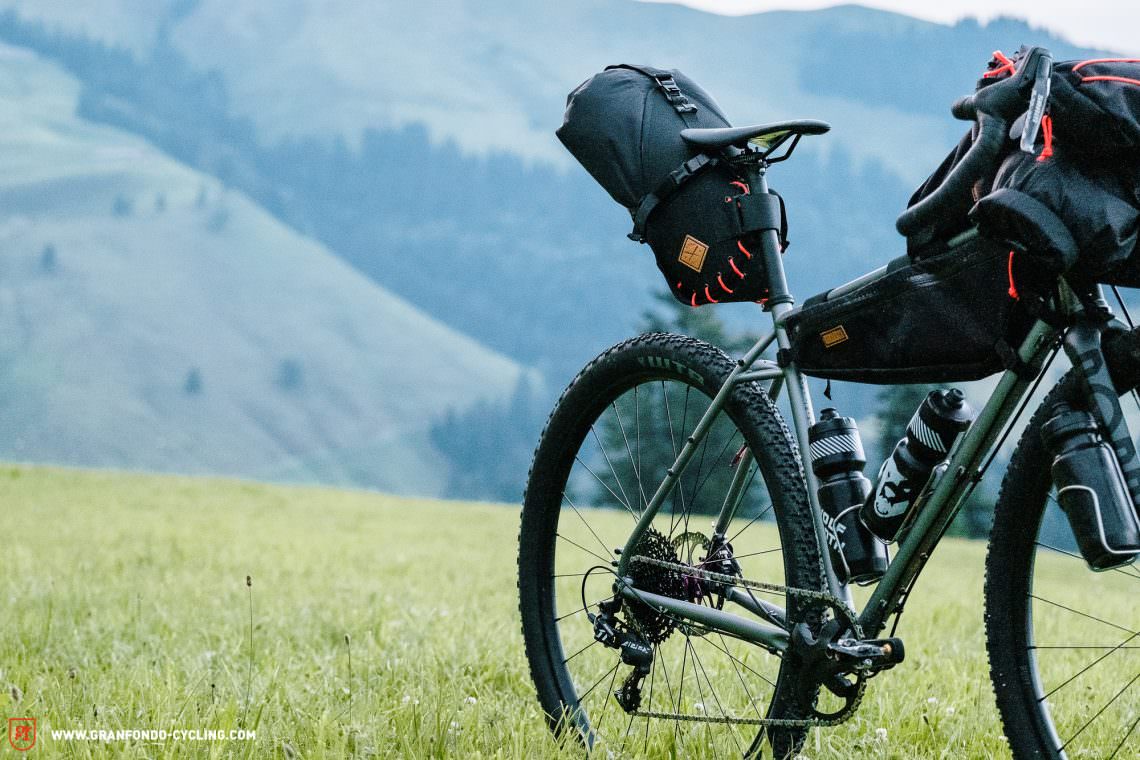
What are the requirements of a gravel bike in this category? In addition to an upright and relaxed riding position, a high level of riding comfort is essential. This isn’t about the most aerodynamic posture possible, or the optimal power output, or a race against the clock. It is much more important that you arrive at your destination after an all-day ride without a stiff neck. Since the bike also has to serve as a pack mule for the whole family, you’ll want sufficient mounting points for luggage racks, bags and water bottles – for a loaded bike, low gearing ratios are mandatory too if you’re going to be tackling steep climbs. If you want to stay clean and dry as you ride there’s no getting around mudguards, for which the frame and fork will need the appropriate eyelets. In case your kids demand all of your attention while you ride, a bike with stable handling that forgives small errors or lapses in attention is just as important for those moments when you’re not looking ahead. The perfect example of gravel bikes in this category are the Fern Chuck Explorer (read review) and the RONDO BOGAN (read review), which have a great combination of relaxed riding position, long-distance comfort, secure handling and lots of mounting points.
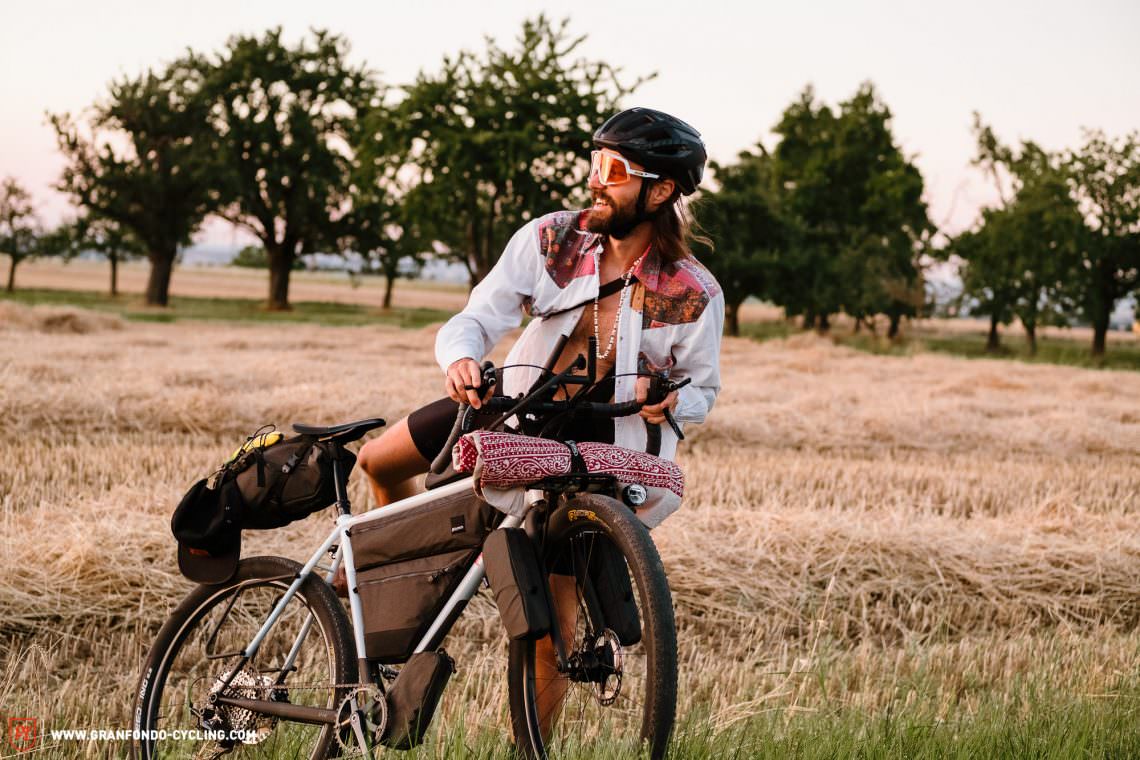
Off-road flow – Racing along mountain bike trails with a gravel bike
Many mountain bikers are in the market for a fast and versatile (second) bike that not only cuts a fine figure on gravel roads and woodland paths but also performs well on their local trails as a full-fledged mountain bike replacement. Even some roadies want a gravel bike as a bad weather substitute for their beloved road bike and a bike that is capable of tackling any forest path and thereby allowing them to experience the joy of riding fast off-road too. Fast, flowing fast trails without big obstacles or jumps are guaranteed to put a smile on your face if you’ve got the appropriate gravel bike!
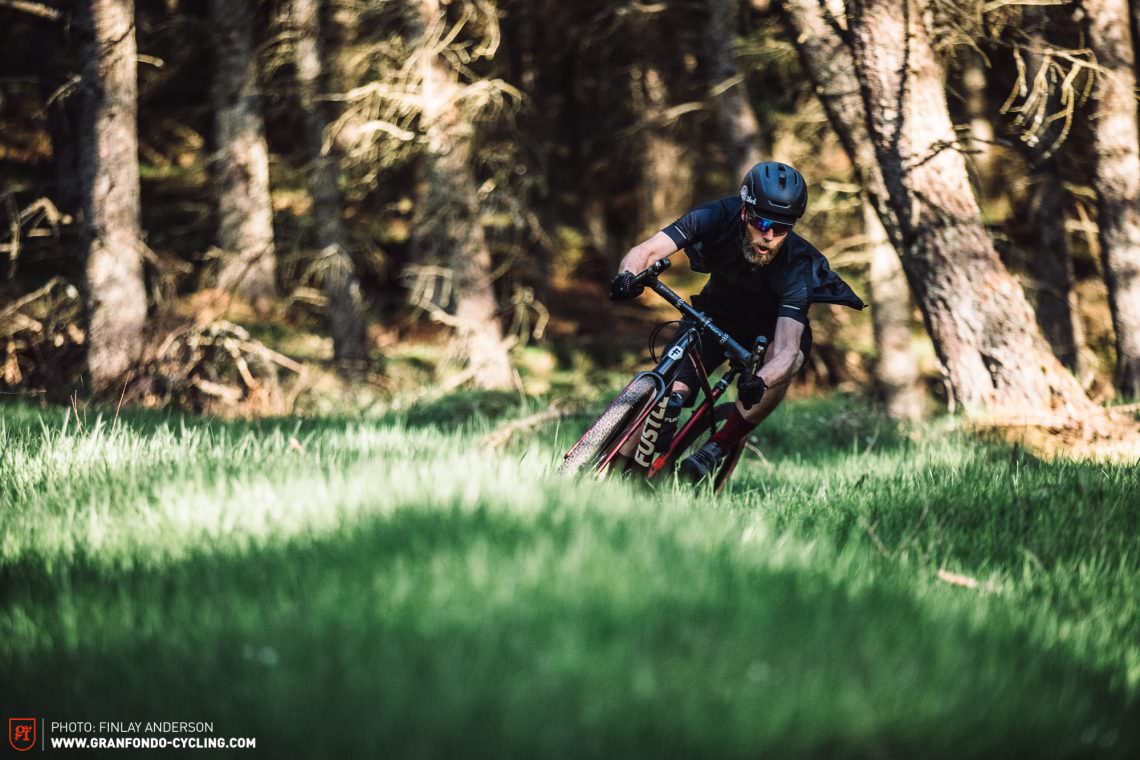
This category of gravel bike doesn’t only feature progressive geometry that bears the DNA of a mountain bike with a slack head angle and long wheelbase, it also has a flared handlebar and a short stem for added control and agility in rough terrain. The frame and fork should offer plenty of tire clearance, allowing you to fit wide tires for sufficient grip when riding off-road. The demands of off-road riding are correspondingly high, which is why gravel bikes with durable and robust components trump the competition in this case. As with the Cannondale Topstone Carbon Lefty 1 (read review), a suspension fork can be a good choice for added comfort and control. The BMC URS 01 ONE (read review) also offers the option of retrofitting a suspension fork. Regarding the brakes, bigger is better. Large rotors offer consistent stopping power on long descents and we recommend going for a bike with a 180 mm rotor up front and 160 mm model on the rear. As you might be familiar with on mountain bikes, dropper posts allow the rider to keep their centre of gravity low on technical or steep descents and they’re becoming increasingly popular on gravel bikes. Prime examples of gravel bikes that combine aggressive geometry, sensible components and a dropper post in one package include the Fustle Causeway GR1 (read review), the Evil Chamois Hagar (read review) and Nukeproof Digger (read article).
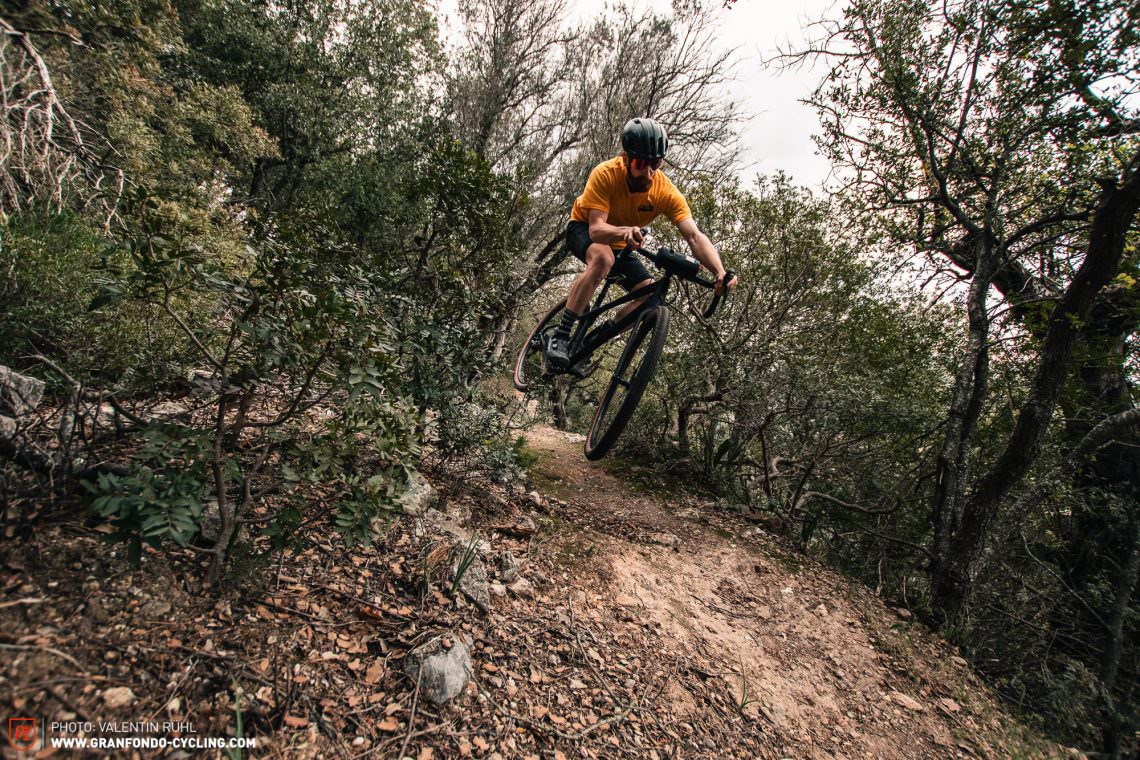
A need for speed – The gravel bike as a road bike alternative
Does the following scenario ring a bell? During the week, you’re busy planning the route for your big Sunday ride on Komoot and, on the screen, every road looks better than the next. Your anticipation grows and the weather forecast predicts a pleasant 22° C with blue skies and not a single cloud. Just 20 km in you start to become disillusioned. The roads have more craters than the surface of the moon, the promised 22 °C feels more like 2.2 °C and big raindrops start falling from the supposedly blue sky – of course, you left your rain jacket neatly hung up in the closet. The grip of your oh-so-fast 700 x 25C tires is almost non-existent and you say three Hail Mary’s after every descent without crashing. Strava KOMs haven’t bothered you for years anyway? Then a gravel bike is the perfect choice for those longer rides when you don’t feel like encountering any nasty surprises!
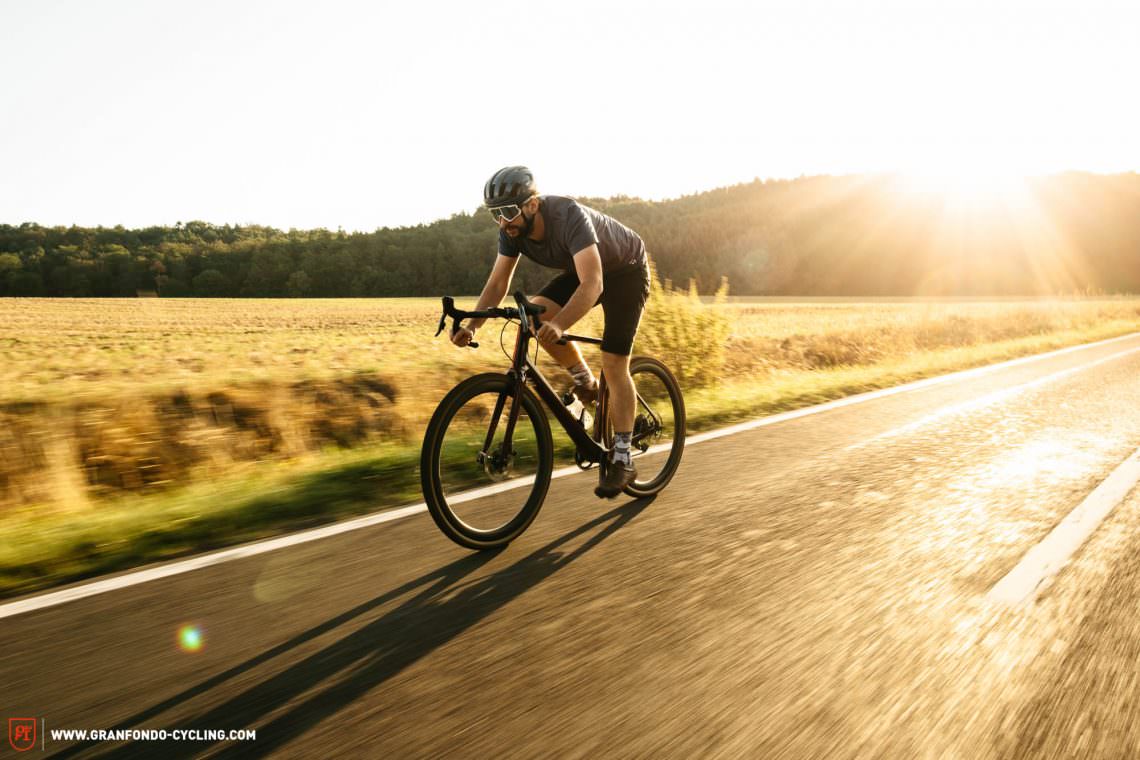
A gravel bike that is used to substitute a road bike must have an aggressive riding position, not too different from the position you’re familiar with on your road bike. After all, you’ll still want to be capable of leaving the one or other road bike in your wake while sprinting down the home straight. For this, the riding position as well as the bike itself need to be somewhat aerodynamic. In order to get as close as possible to the feeling of a road bike, handling and weight also play an important role. In other words, this kind of gravel bike should offer lively and agile handling. Two bikes that transfer all of these characteristics to poor roads and gravel are the Specialized Diverge (read review) and Cervélo Áspero (read review). Even more closely related to road bikes are the Trek Domane SLR 9 eTap (read review) and Standert Pfadfinder (read review).
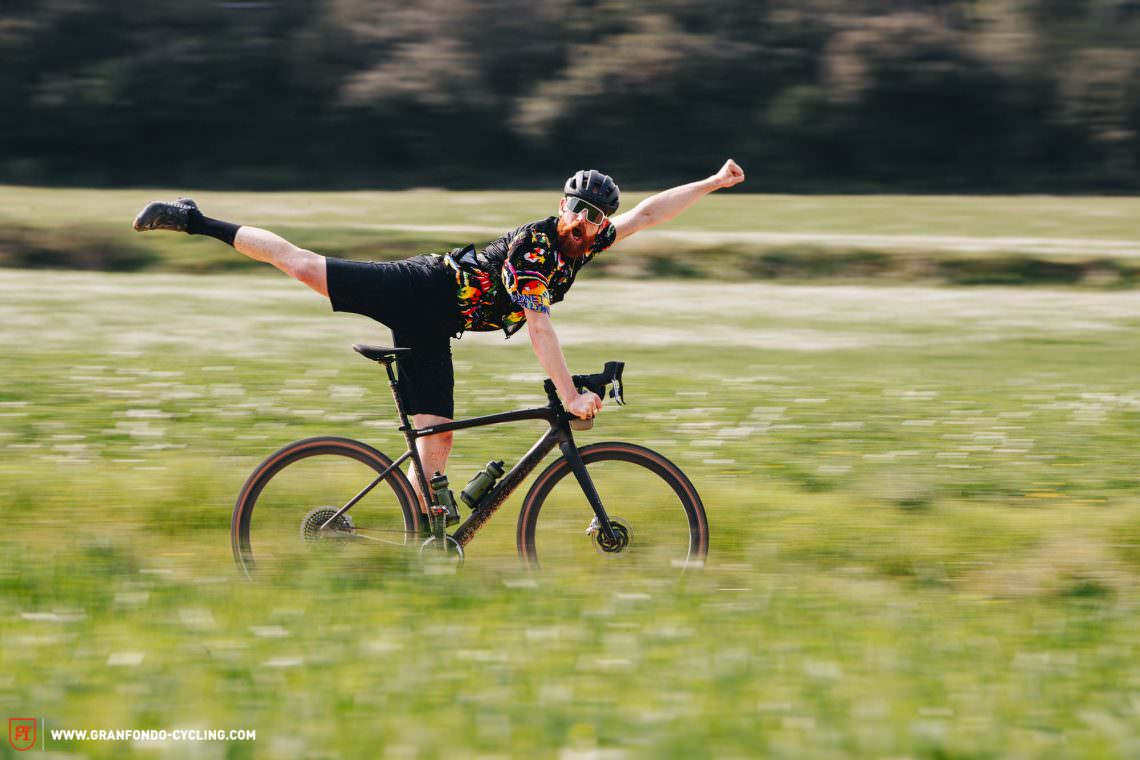
Everyday heroes – The gravel bike for commuting, shopping and going to the pub
To blame everything on the car as an outdated pollution machine would be a cop-out. Particularly in rural areas with poor infrastructure, there is no avoiding cars and many of us couldn’t cope without them at least to some extent. Sure, a cargo bike (click here for the cargo bike group test in our sister magazine DOWNTOWN) can be an alternative but it’s not the perfect choice for everyday commuting. Besides making great commuters, some gravel bikes can also function as pack mules for shopping, or as a simple tool to get from A to B, or even just to the pub and back. You no longer need the second car standing in your garage, which only eats up your money in the form of tax and insurance premiums anyway.
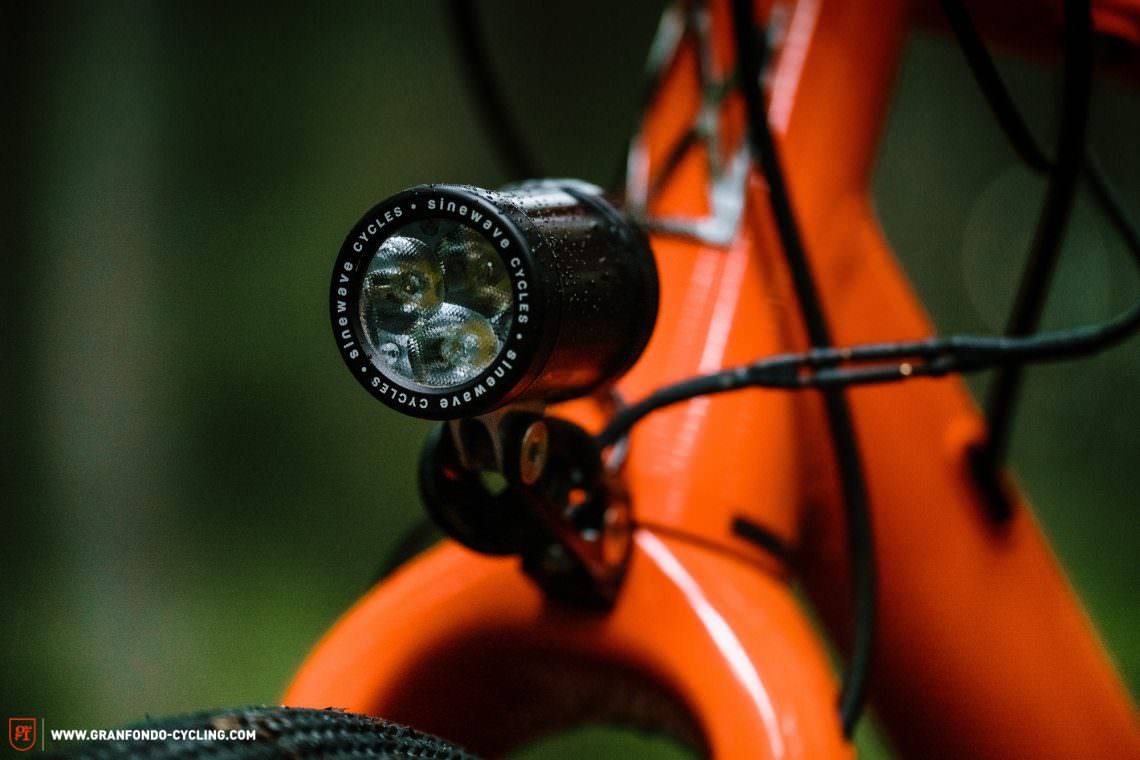
If you’re going to use a gravel bike this way, the option of mounting mudguards and racks is a must. Who wants to arrive at the office soaking wet and splashed full of mud or have to haul their laptop in a backpack on their back? Even if not having any lights on your bike is a good excuse for arriving late and leaving work early in the winter, you’ll desperately wish you had a light when riding home in the complete dark shortly before midnight after enjoying a delicious pizza and a drink after work. A set of lights hooked up to a hub dynamo has the great advantage of not needing batteries, offering a reliable and steady source of illumination. All too often you’ll forget to charge your battery-operated light and you can be sure that it will be empty on the night of a new moon. Since your gravel bike will ideally rack up many kilometres and, if you’re honest with yourself, it won’t get cleaned after every ride in the rain, it’s important to look for a durable and robust build as well as hard-wearing, puncture-resistant tires. You shouldn’t pay too much attention to the weight, as durability and easy maintenance take precedence. In terms of their riding position, everyday gravel bikes differ significantly from that of their more competitive counterparts, allowing you to stay a lot more relaxed on the bike. Both the Kona Libre AL (read review) and the Felt Breed 20 (read review) are the perfect examples of gravel bikes, which aren’t just suited as adventure bikes for the gravel, but as a reliable partner for everyday riding.

Fight for the podium – The gravel racer
Admittedly, the gravel racing scene is in its infancy and the choice of races is still limited in many places. While you can find an event almost everywhere you go in the road or mountain bike worlds, you have to travel a lot further for a thoroughbred gravel race. However, thanks to the growing market and the fact that human beings tend to strive for competition and recognition, the gravel race scene is growing steadily.
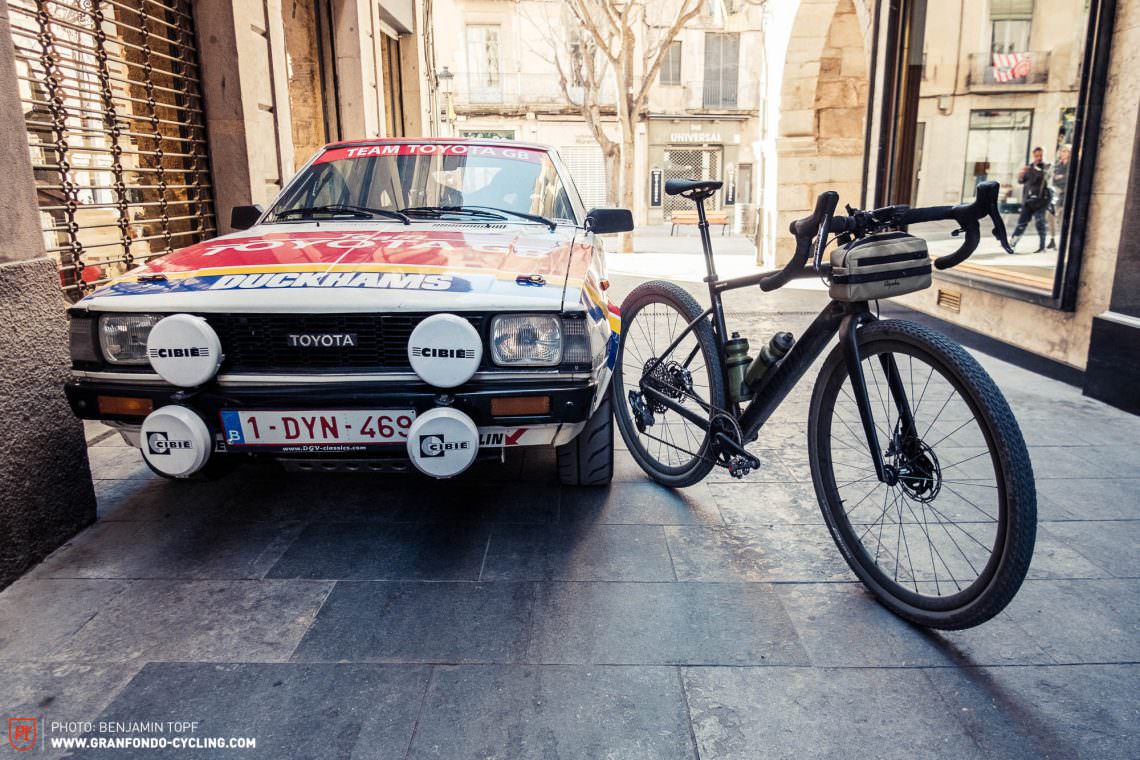
The list of requirements for a gravel bike that will shave off valuable seconds in a race is completely geared towards maximum speed. Aerodynamics play a crucial role at speeds above 25 km/h, which is why not only the bike and its components should be aerodynamically optimised but also the riding position. Mounting points and versatility take a back seat here. What counts is minimal weight and fast-rolling tires. However, it’s been found that an overly stiff gravel bike can be counterproductive in a race. Smoother is faster. A comfortable bike keeps you and your muscles fresher for longer, which means that you’ll still have enough reserves in the tank for the final, decisive kilometres of the race. Ideal candidates in this category are the Specialized S-Works Diverge (read review) and the Cervélo Áspero (read review), which, thanks to their low weight, good aerodynamics and high efficiency are guaranteed to land you a podium – the right rider allowing of course.

Around the world ticket – The bikepacking gravel bike
For many of us, our environmental awareness is changing and with that, the way we travel. Of course, long-haul flights, distant continents and foreign cultures haven’t lost their appeal. However, often all it takes to experience an unforgettable holiday in the outdoors is a short trip by car, train or even starting from your doorstep on your bike. Globally, bikepacking has become more popular than ever and it is one of the most beautiful, intense and gentle ways to explore the earth.
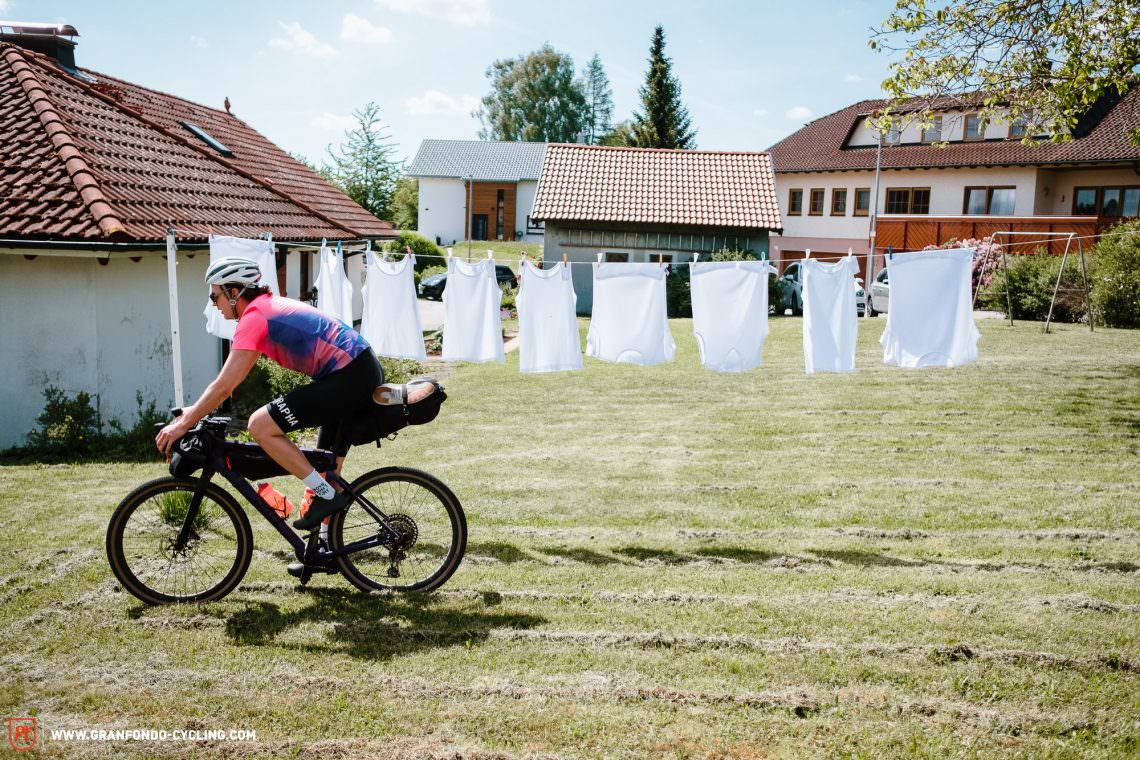
First things first: we’ve already determined the perfect bikepacking bike for you in our big bikepacking group test (available here) and the Salsa Cutthroat (read review) was the deserved winner of this test. The Salsa offers a comfortable and upright riding position which, given that a lot of bikepackers ride for more than six hours a day for weeks on end, is only possible and fun if you’ve got a suitably relaxed posture. In addition to having as many bosses and eyelets as possible to be able to carry water bottles, food and luggage, you’ll also want a sturdy frame that is capable of carrying all of this additional weight while still being easy and safe to ride. Versatility and long-distance suitability also play a huge role for bikepacking bikes. We’ve previously written a detailed guide with all the important features a bikepacking bike should have (available in a separate article here). Click here for our Bikepacking 101 if you want to know everything about bikes, gear, route planning and accommodation.
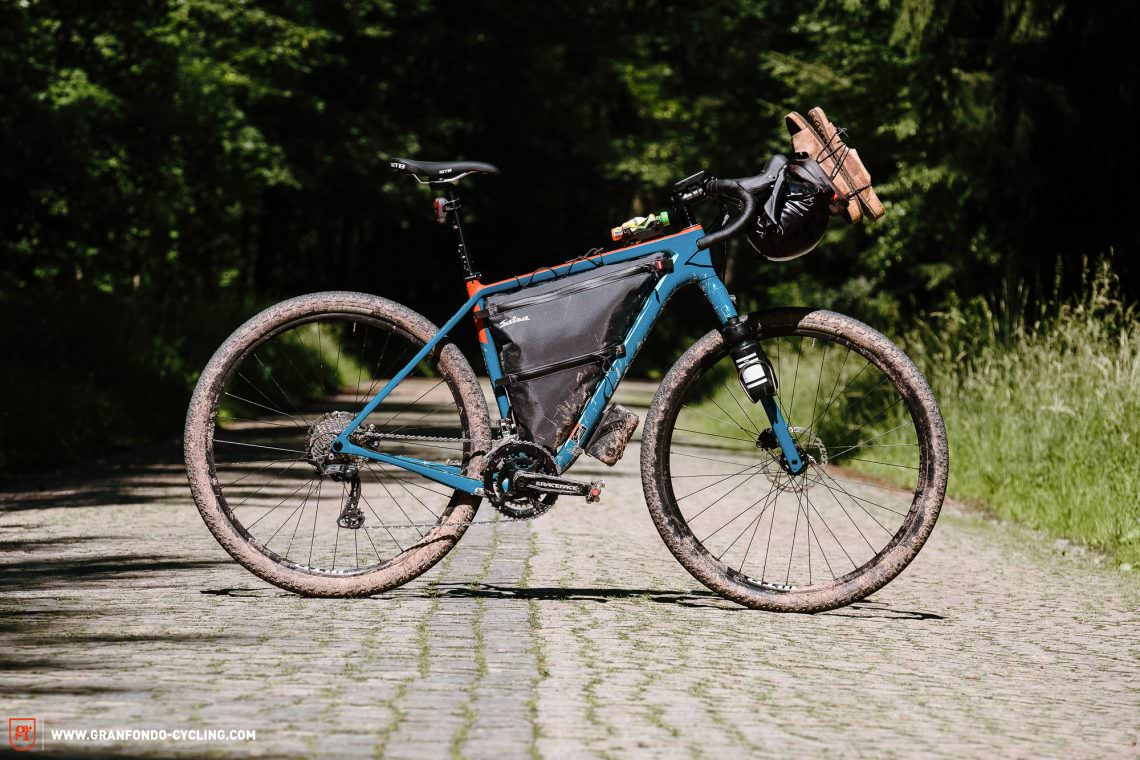
Hype is our religion – The trendy gravel bike
Are only the newest and hottest components good enough for your bike and are you usually the first to click the order button when a new product is released? Price isn’t an issue, you’re willing to spend a lot on your bike and it should look expensive too. If that’s the case, understatement is the last thing you want when cruising through town. You want the bike to attract attention and you don’t mind the admiring (and envious) looks cast your way.
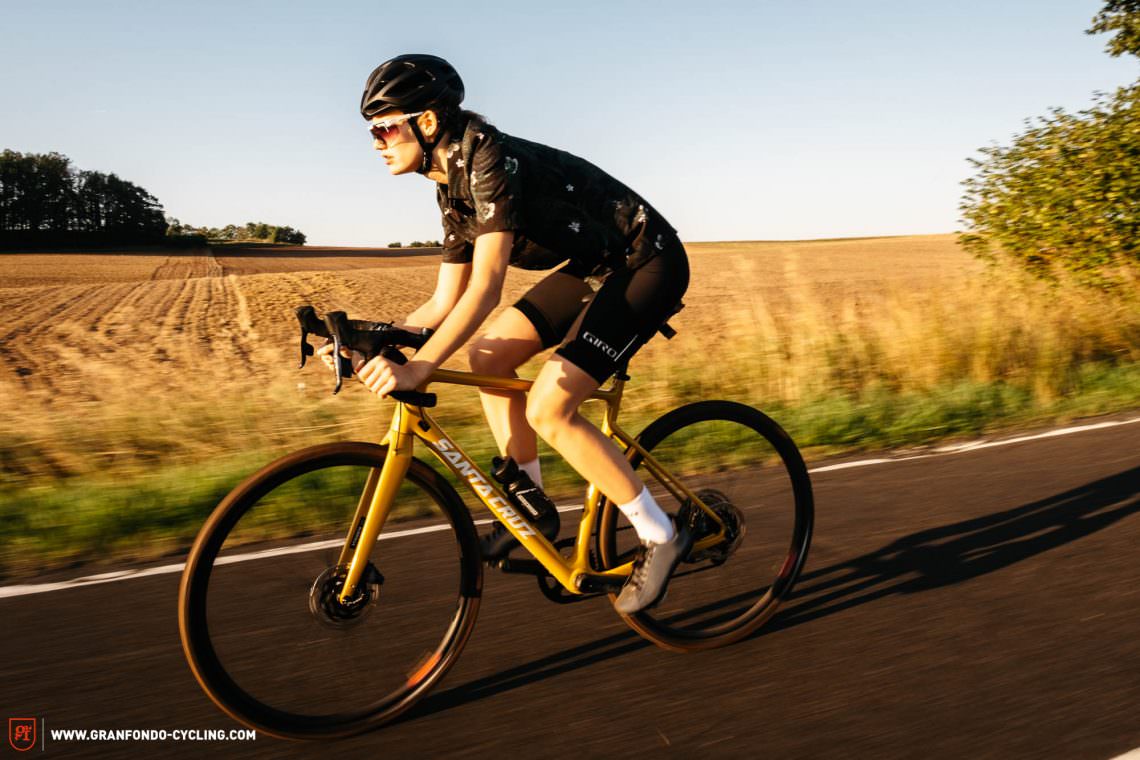
Compared to gravel bikes of other categories, the trendy gravel bike doesn’t care about inner values. It’s only looks that matter! No one would photograph an ugly bike just because it’s comfortable or efficient to ride. Bling-bling is all the rage and in addition to deep profile rims and a striking paint job on the carbon frame, tan-wall tires are a must. Eye-catching features are just as welcome as anodised CNC components and crazy-light carbon construction. The riding position doesn’t even have to be particularly comfortable, true to the motto that beauty is pain. Exotica like the Festka One Gravel (read review), the Thomson titanium gravel bike (read article), the Pivot Vault Team Force (read review) or the Santa Cruz Stigmata CC (read review) fit perfectly into this category.
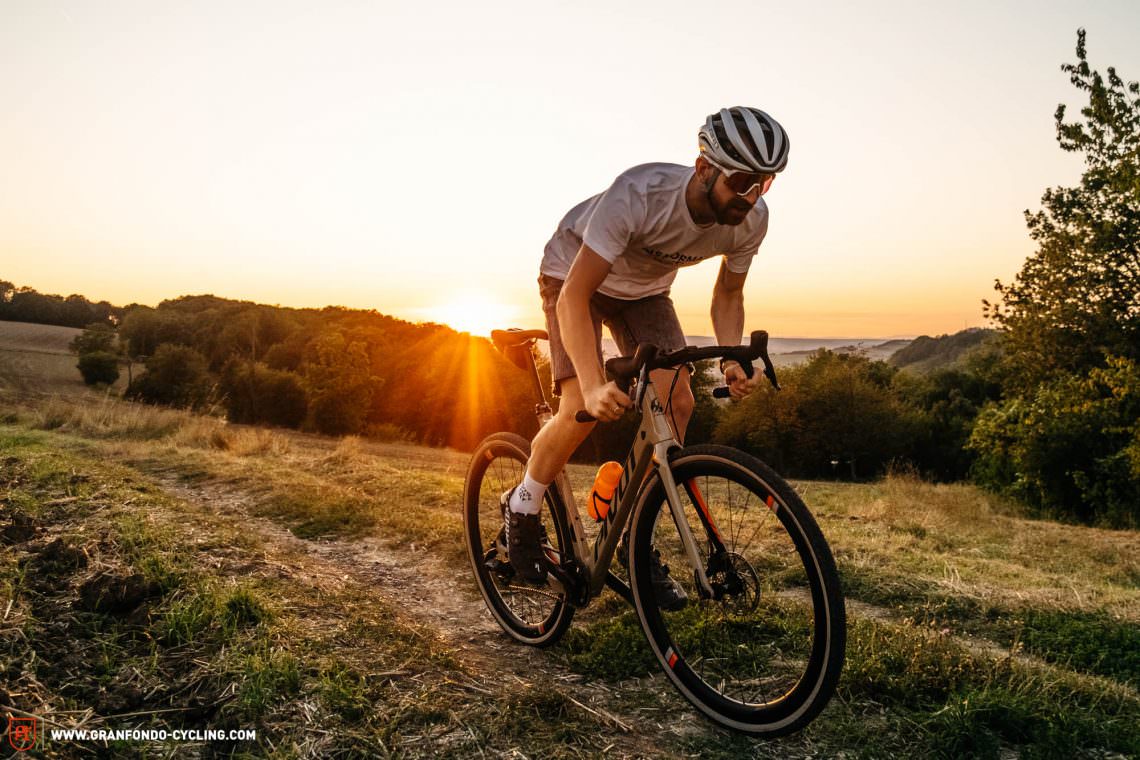
A little bit of everything – The ultimate all-rounder
You can only or want to own just one bike that is capable of handling whatever you throw at it? Whether on your daily commute to work, after work, or on a multi-day bikepacking trip, the ultimate all-rounder will never let you down. However, you shouldn’t expect this kind of bike to excel at any specific discipline and other, more specialised bikes will perform better at gravel races or on bikepacking adventures.

A gravel bike in this category should be a lot of fun to ride with stable handling that instils the rider with confidence regardless of the terrain. A descent on a poorly maintained asphalt road is just as much fun as an off-road excursion on a flow trail originally designed for mountain bikes. The bike mustn’t weigh too much and you’ll also want a wide gear range to be able to conquer steep gravel climbs even when the bike is loaded. The handling of an all-round gravel bike should be intuitive and balanced, allowing anyone from seasoned veterans to beginners to get along with the bike. In our latest gravel bike group test, we went in search of the best all-rounder and after riding countless kilometres, it was clear to all of the test riders that the OPEN WI.DE. (click for review) is unbeatable when it comes to all-round capabilities!
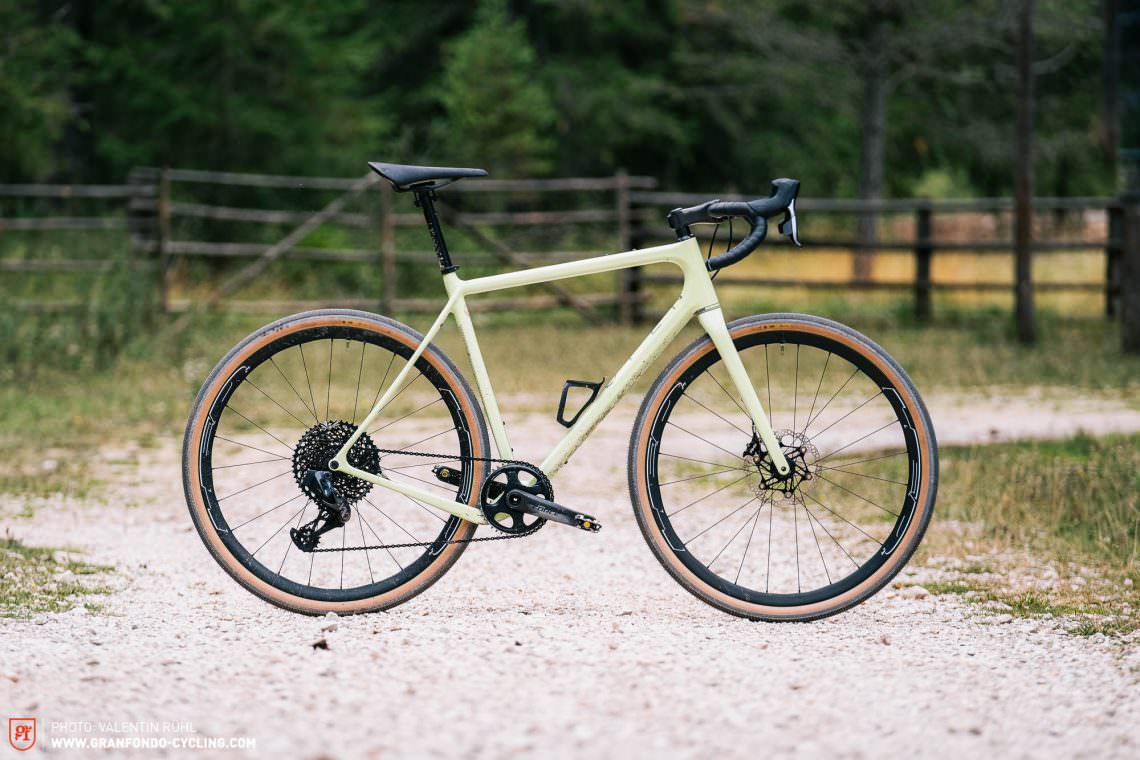
Tailored to your needs – The custom gravel frame
Have you been riding bikes with drop handlebars longer than you can remember, even racking up a five-digit number of kilometres on your gravel bike in recent years? In that case, you probably know exactly what you like and what you don’t like on a bike. If you’ve ever caught yourself thinking about designing gravel bikes or sketching them on paper, then you’re in the right place with a custom gravel frame. People with unusual body proportions who’ve been excluded from the market are a perfect fit for this category too, finally allowing them to own that dream bike with twice as much stack as reach. You’ll find a perfectly tailored bike with smaller builders like Fern and their Fern Chuck Explorer (read review), Festka (read review of Festka One Gravel) or Legor and the Legor Cicli LWTUA (read review).
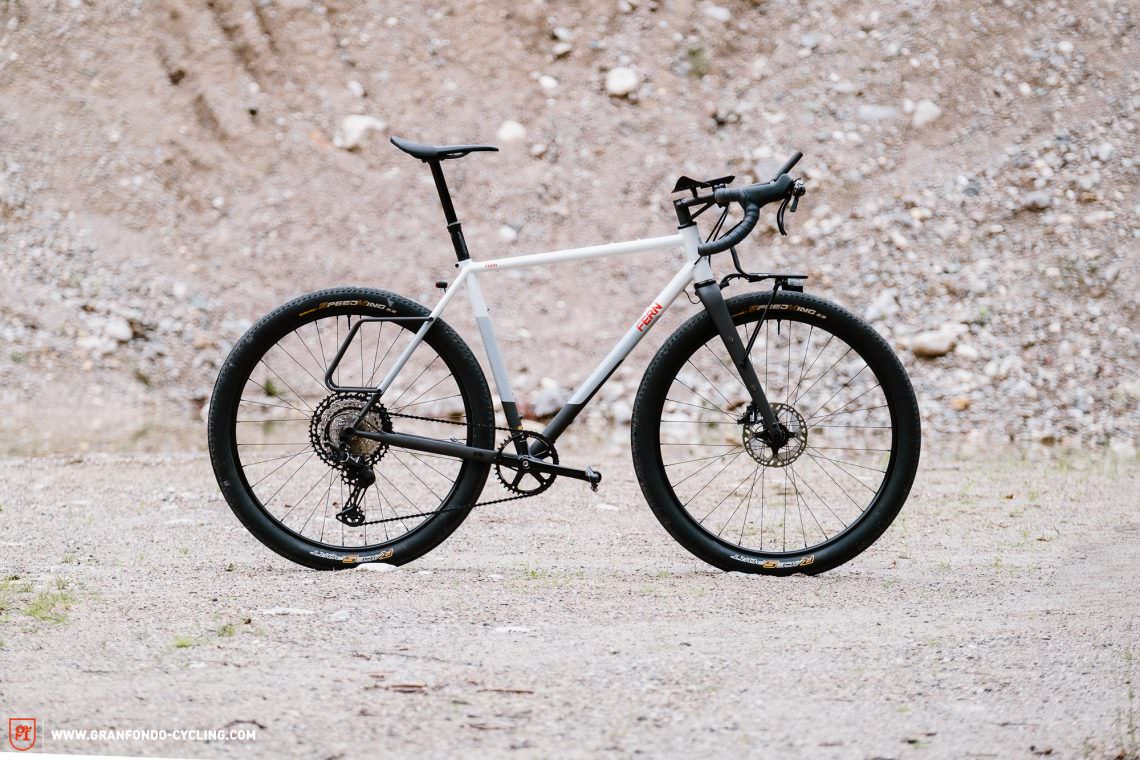
How does a gravel bike differ from other bikes?
At first glance, most gravel bikes just look like normal CX or road bikes with wider tires. But this impression is deceptive as there can be significant differences in their geometry. In the next part, we list the most important differences between gravel, cyclocross and mountain bikes.
Gravel vs cyclocross bike
Compared to gravel bikes, cyclocross bikes are high-performance machines designed for short races on often muddy tracks. The tire clearance is regulated by the UCI to a maximum of 700 x 33C, whereas some gravel bikes have enough clearance for mountain bike tires up to 700 x 55C wide. While the seat and head tube angles, combined with a low stack, are very similar on road and cyclocross bikes, gravel bikes usually have slacker head angles for more stable handling on rough terrain. Similar to endurance road bikes, they typically have a longer head tube and thus a higher stack for a more comfortable and upright riding position. You’ll often find that gravel bikes have shorter stems too. On some models, the top tube drops significantly towards the seat tube to offer increased standover height and freedom of movement, which lets you feel more confident on the bike.
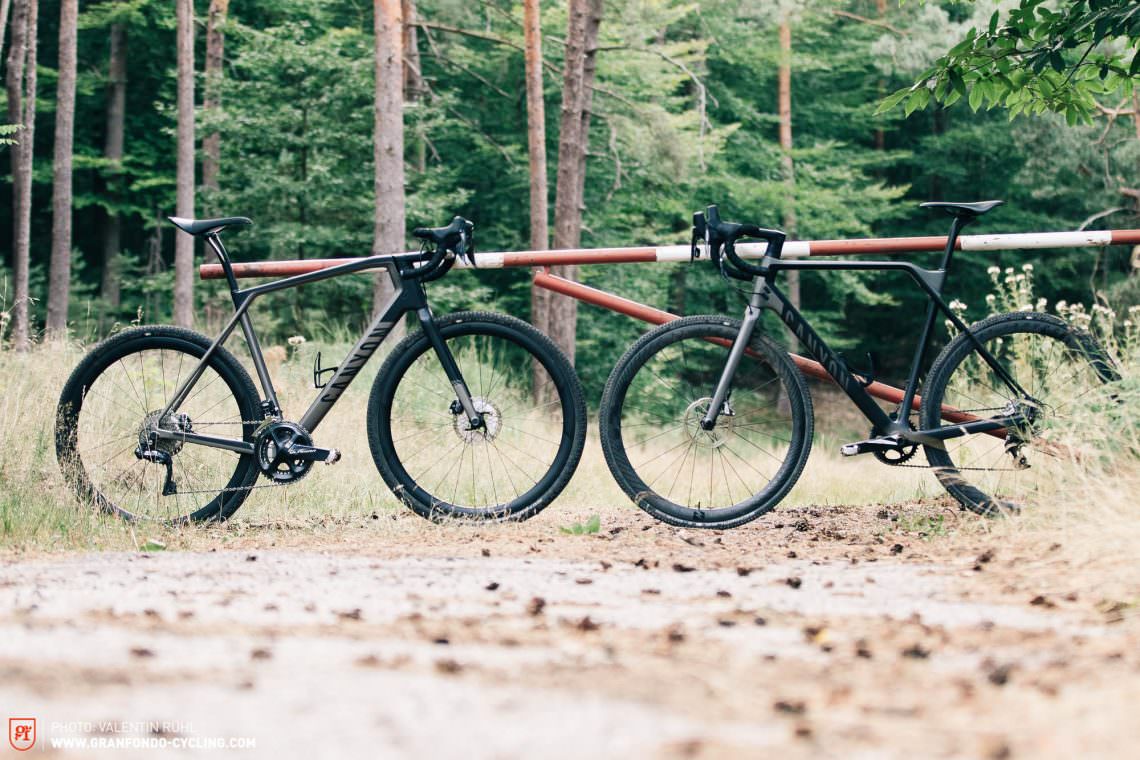

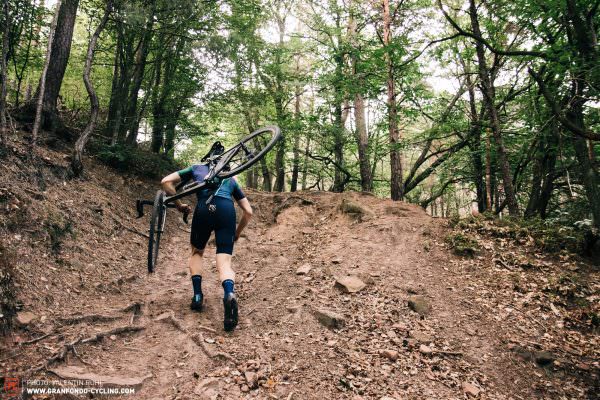
Gravel bike vs mountain bike
The more you ride off-road, the clearer the differences between gravel and mountain bikes become. While a 29” gravel bike often has more in common with a mountain bike than a road bike, the frame is designed for drop bars, which means the top tube is comparatively short. Mounting a drop bar on a normal mountain bike would mean having to size down. However, with more and more suspension designs found on gravel bikes, the question does arise what advantage they offer over a hardtail. In truth, there’s not that much difference anymore and in the end, it’s a matter of taste. At the fork between gravel and trail, often it will be personal preference, the aesthetics and bikes your friends ride that will determine the choice. 😉 If you want to find out how a purebred XC bike does against a gravel bike, you can read our test of the Trek Procaliber 9.9 SL Race Shop (read review).
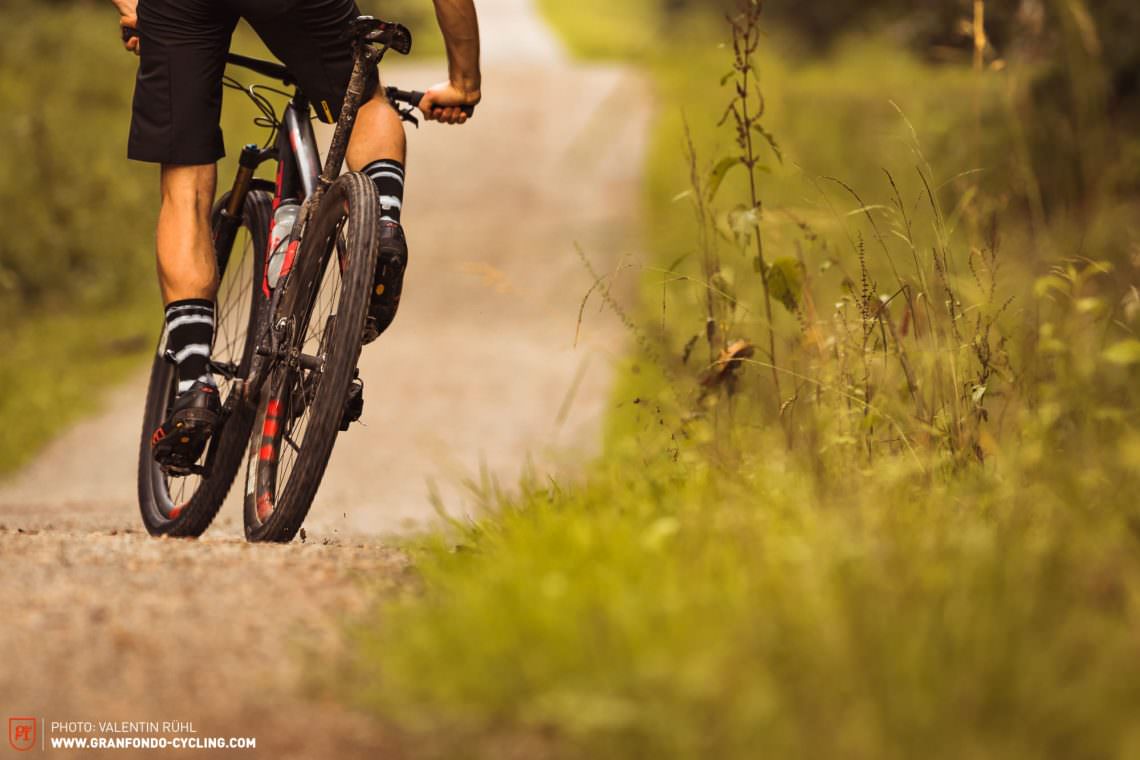
Is an E-gravel bike the right bike for you?
After conquering the mountain and trekking bike market, the triumphant advancement of motorised two-wheelers isn’t stopping at bikes with drop handlebars and in the last few months, we’ve had numerous E-gravel bikes in for testing in the form of the Cannondale Topstone Carbon Neo Lefty 1 (read review), Canyon Grail:ON CF 8 eTap (read review), Moustache Dimanche 29 (read review), LOOK e-765 Gravel (read review) and Specialized Turbo Creo SL Expert EVO (read review). Niner recently released the RLT e9 RDO (read article), a motorised gravel bike, too. Competitive riders who often ride on flat terrain at high speed will only be slowed down by an E-gravel bike. However, less fit gravel fans can benefit from the support of the motor in a lot of situations, allowing them to keep up with faster riders in a group when before they were left far behind. Those impossible climbs are no longer a problem with an E-gravel bike either and even longer day trips suddenly start looking a lot less daunting.
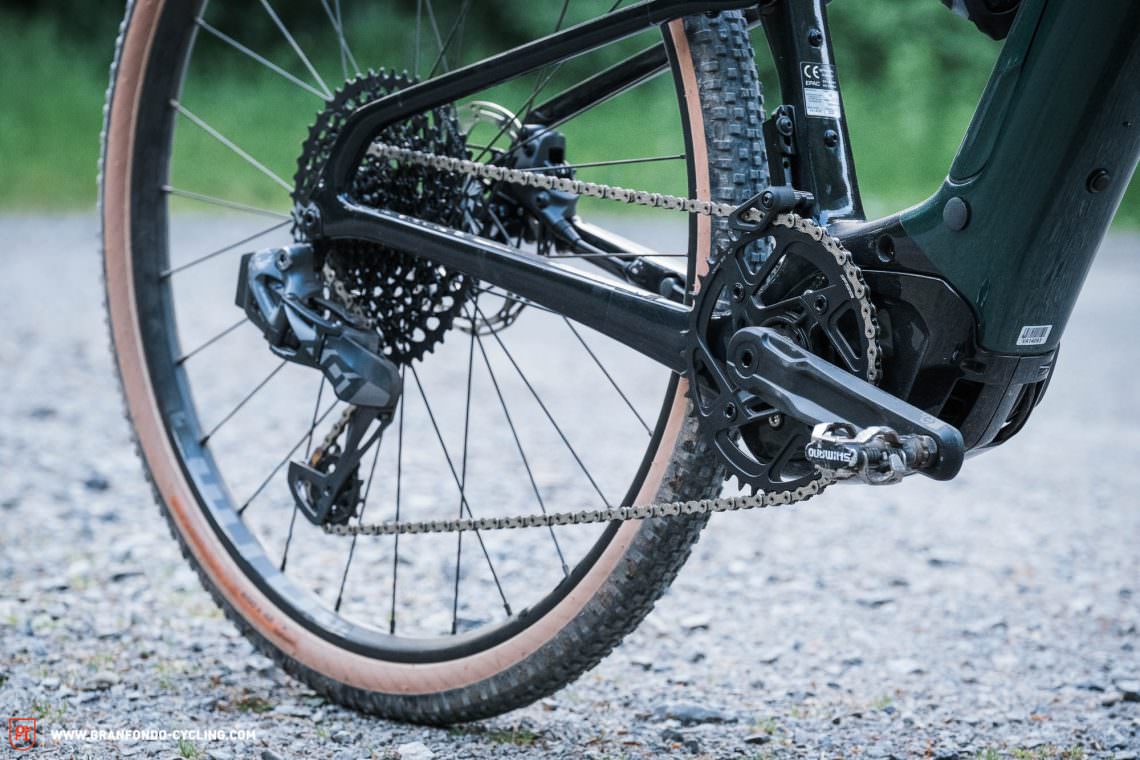
We know that range is a hot topic in this context. However, there’s no way of making any reliable statements on this as the range depends on various factors such as the riding style, the rider’s weight and the time spent above the 25 km/h limit. For more information about this, we can recommend an article published in our sister magazine E-MOUNTAINBIKE, “The truth about lab tests”. We’ve also conducted a group test of the most common motors used in the road and gravel bike sector, such as Mahle or FAZUA (available here).
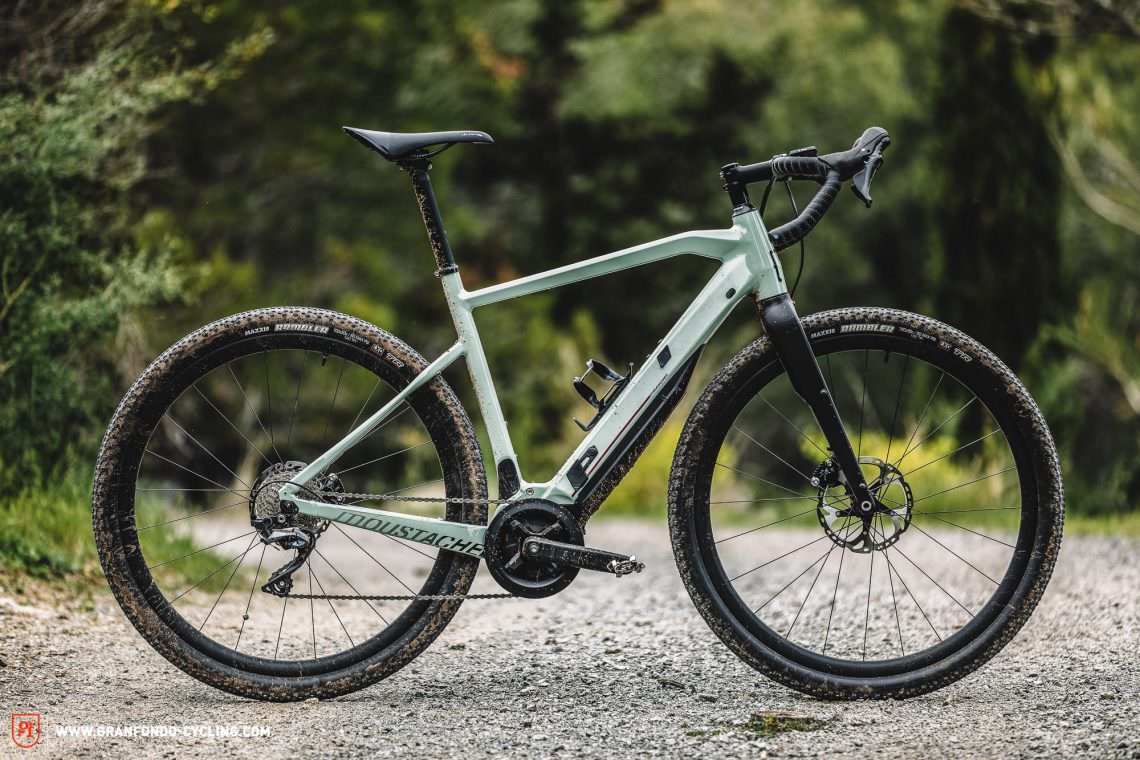
Gravel bike fit & feel – Choosing the right frame size
Compared to road bikes, there’s not much different about gravel bikes when it comes to the choice of frame size. Those who ride a 54 cm road bike will also ride a gravel bike with these dimensions. The only thing of note is that many brands work with an S, M and L sizing system instead of indicating the size in centimetres and they often only have three or four frame sizes available. However, this is relatively unproblematic as you move around on the bike a lot more and don’t stay in one position as long as you would on a road bike due to the frequently changing terrain of a typical gravel ride. As such, the frame can be a bit too small or big without causing any issues. If you find yourself between sizes, the following rule applies: choose the larger frame if you’re intending to do long rides or multi-day trips and the smaller one if you’re going for shorter, more intense rides.
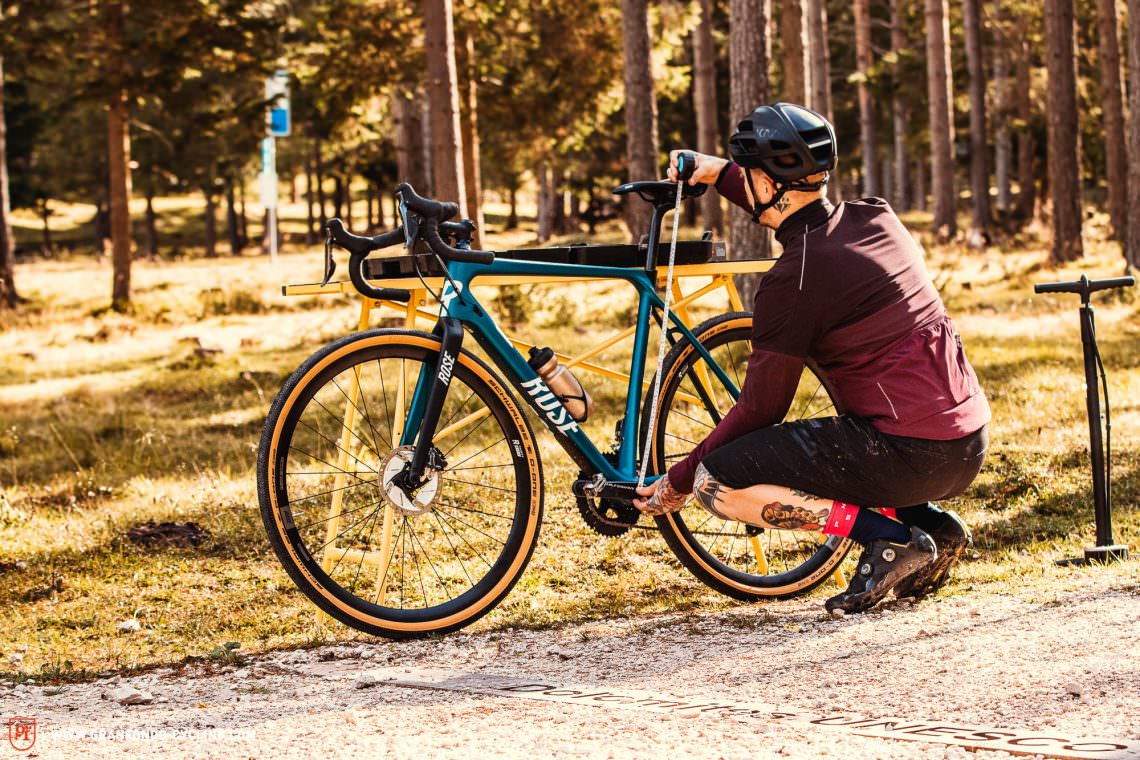
Companies such as Retül or other bike fitters that specialise in this field can help you find the bike with the right geometry. For more information on the all-important topic of bike fitting, we recommend checking out our article “The truth about bike fitting”. In general, when determining the size at home with a measuring tape, you need to keep in mind that leg length is by no means the only thing that matters. Torso and arm length also play an important role in finding the right frame size. You will find a frame size calculator online at jensonusa.com that takes all important body proportions into account. Of course, if the frame size doesn’t fit perfectly or the geometry isn’t entirely optimal for the respective rider, the riding position can still be tuned through stem length or angle and the offset of the seat post. However, this is no substitute for the correct frame size!
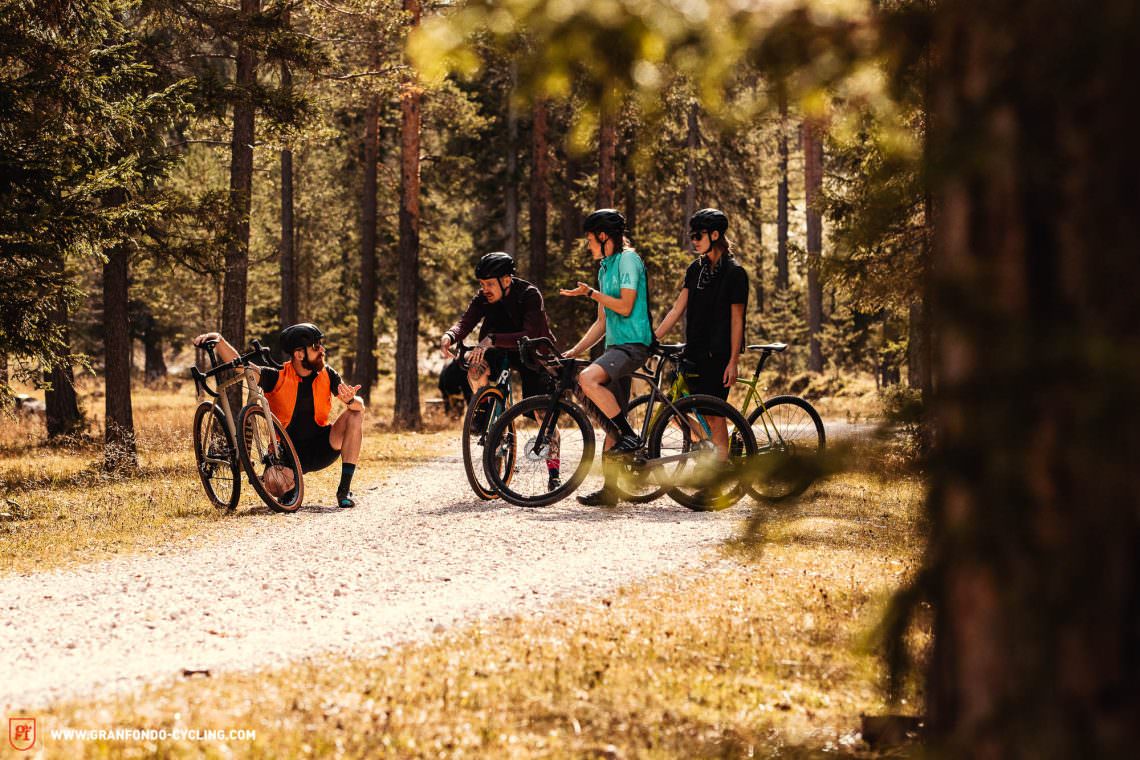
With the growth of the market, you’ll now also find suitable production gravel bikes for very small riders. The Salsa Journeyman 24 (read article) is perfect for children and people who are less than 1.60 m tall, offering a reach of just 342 mm and a stack of 437 mm. The Canyon Grail (read review) is also available in sizes XXS and XS, which roll on smaller 27.5″ wheels. With such small frames, you should be careful of toe overlap. The geometry of the size 49 Specialized Diverge (read review) is adapted to make toe overlap impossible.
What does a good gravel bike cost?
When looking for the best all-rounder gravel bike in our latest group test, the average price of the test field was € 5,673. Of course, this is partly due to the fact that the participating brands sent us their flagship models with only the best components. However, it is also interesting to note that, according to our last reader survey with more than 8,000 participants, you want to spend around € 4,000 on your next bike. That said, the good news for anyone who doesn’t want to invest four or five grand is that you’ll be able to find really good gravel bikes that will bring you just as much joy for significantly less money!
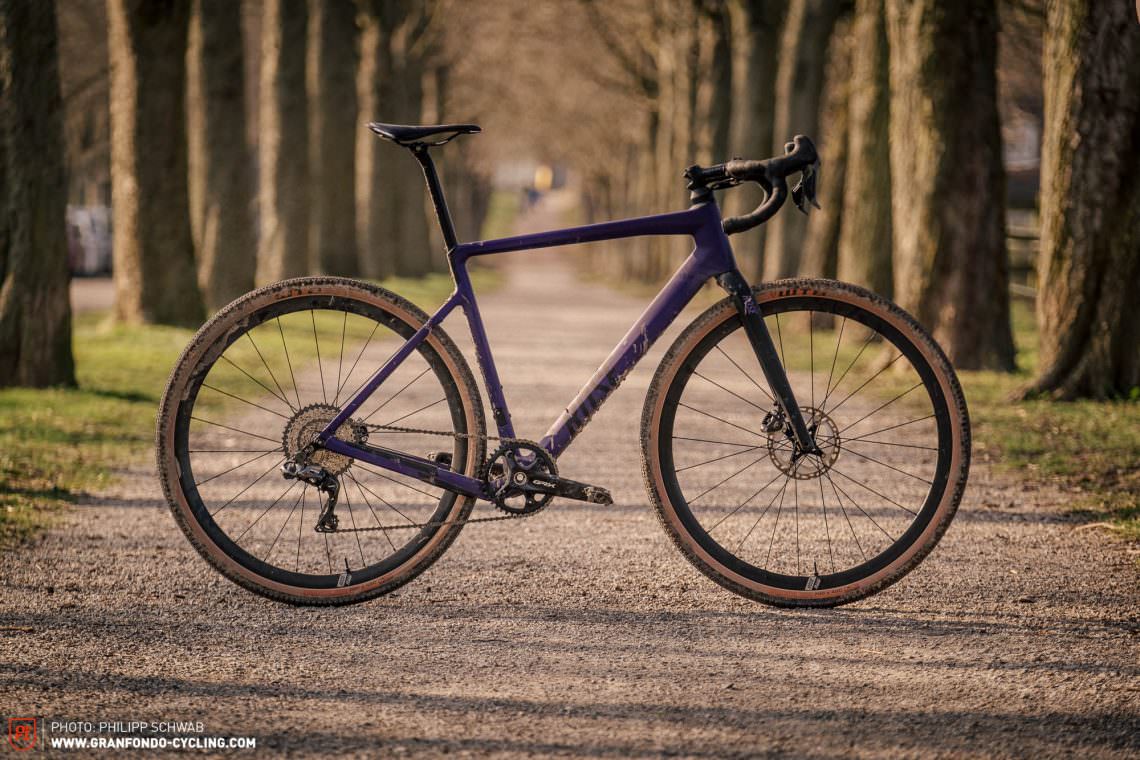
The Canyon Grail starting at € 1,459 (read review), the ROSE BACKROAD at € 1,549 (rear review) and the Felt Breed at € 1,699 (read review), are your entry-level gravel bike options. With these, you get a lot of gravel bike for comparatively little money and in some cases, the bikes perform even better in certain areas than much more expensive models. Of course, you’ll have to make do without expensive carbon frames and components, electronic groupsets or other expensive tech with these entry-level bikes. However, particularly for those new to gravel, these bikes offer everything you need to get started! It is important to note at this point that you’ll need to buy a few other things besides just a gravel bike. You’ll also have to budget for a helmet, an outfit and other gear. More on that later!
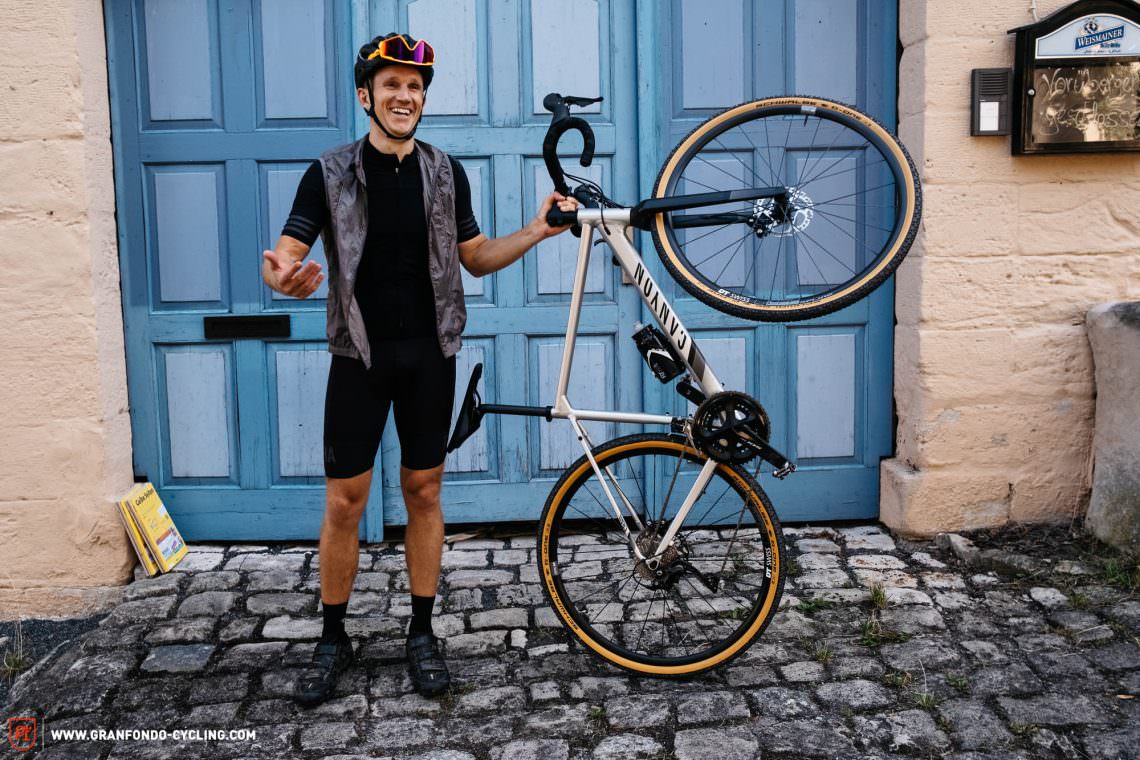
Where can I find the latest gravel bikes? Which is the best gravel bike of 2021?
The gravel bike market continues to grow exponentially and new bikes are introduced every week that all have one thing in common: they promise to be the world’s best gravel bike. We continually review the latest bikes so that we can provide you with an up-to-date overview of new additions to the market and how they perform in real-world tests. You can find an overview of all the most recently reviewed bikes on our site (click here), and we also recommend checking out our current gravel bike group test (available here). If you’re looking specifically for a bikepacking bike with drop handlebars, we recommend taking a look at our group test of the best bikepacking bikes ( click here).

The most important tips for buying a gravel bike
Hopefully, with the help of our buyer’s guide above, you’ve been able to get a clearer idea of the kind of gravel bike you want and actually need. Now, all that’s left to do is figure out where and how to buy it. With the following tips, we’ll help you find the right dealer and ultimately even save some money.
Should you buy your gravel bike online or from a local retailer?
Increasingly, brands will deliver their gravel bikes right to your doorstep. The best examples of this are ROSE, with the ROSE BACKROAD GRX RX810 Di2 (read review), and Canyon, with the Canyon Grail AL 7.0 SL (read review). By eliminating the middleman, these bikes are usually more affordable, but you’ll have to do some assembly yourself, such as adjusting the contact points. You usually won’t have someone you can speak to locally either in case you run into any problems. Only a few direct to consumer brands work together with regional service partners. It is worthwhile carefully finding out yourself beforehand.
Do we recommend used gravel bikes?
Should you buy a new or a used gravel bike? This a decision you will have to make yourself. Experience has shown that after the first 1,500 km the bike will need a little maintenance, such as replacing the chain or tires, which you’ll have to budget for – but more on this later. Nevertheless, with a flawless service history and a relatively new model, you can definitely find bargains on the used market. However, it takes some experience to find a good deal. Private sales usually don’t come with any kind of guarantees and you won’t always notice all the defects a bike has at first glance when viewing it in someone else’s dimly lit garage. A big advantage of a used gravel bike is that you can get a taste of gravel even when you’re on a tight budget. If, contrary to expectations, gravel riding doesn’t appeal to you after all, the bike can be resold with little or no loss of value. Pay particular attention to the person you’re buying from, their know-how and the type of rider they are! Many gravel bikes have never encountered an actual gravel road, which means that wear and tear is usually limited. This article on the subject of second-hand bikes was published in our sister magazine E-MOUNTAINBIKE and has many useful tips that are just as applicable when buying a gravel bike. There you will find a host of important questions and answers as well as a checklist that our colleagues compiled, available as a free download.
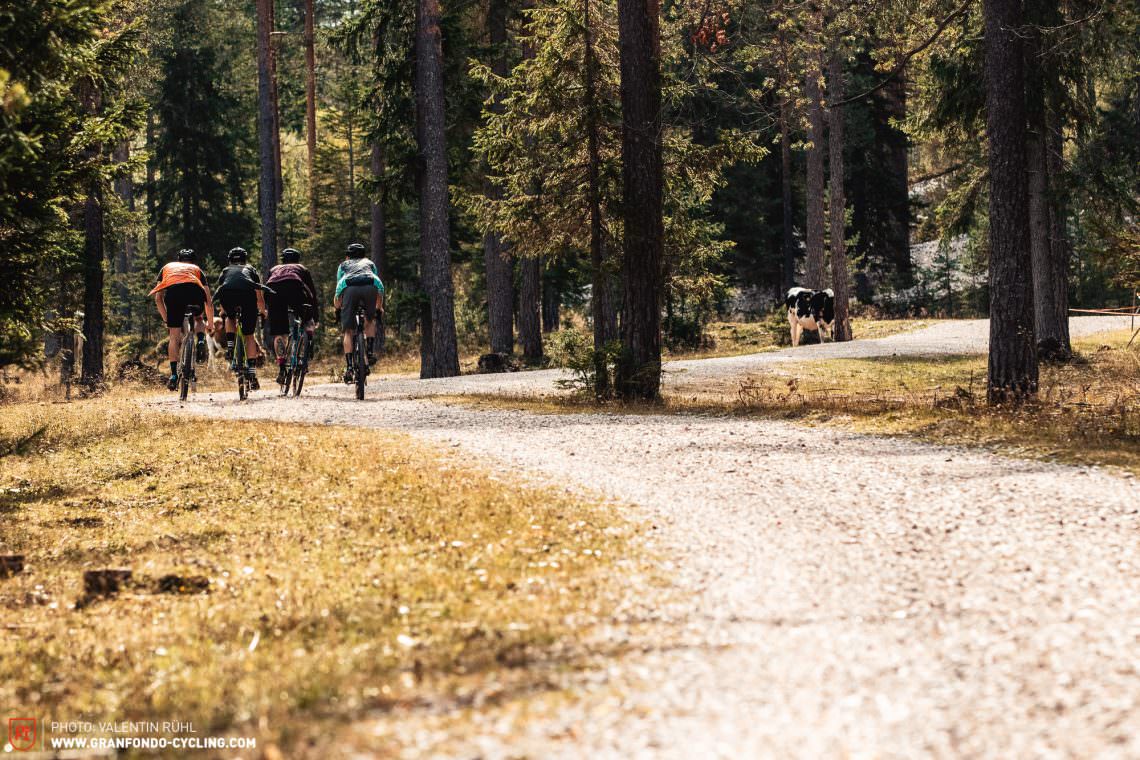
What about supermarket gravel bikes?
Anyone interested in gravel bikes sold at supermarkets should be aware that these models are almost all inferior in terms of componentry, frame and, more generally, their quality. We would generally advise against buying a gravel bike for less than € 1,500. If the frame snaps or the brakes fail, it could cost you your life, even when you’re riding slowly!
What financing options are there? How do I pay for my gravel bike?
The classic purchase – Cash, card or on account
Cash is king? Those who prefer cash payments are a dying breed but the majority of bikes still get paid for as soon as they leave the shop floor, either in cash or by debit card, settling the bill immediately. Goods in exchange for money – for many this is still the most honest and direct form of trade.
Advantages the most likely way for the dealer to offer a discount is with cash payments.
Disadvantages You have to have the full amount due. However, some retailers also offer alternative payment methods like a partial payment in cash with the balance being paid in monthly instalments. Speak to your dealer and see what they can offer you.
The 0% financing option from bike dealers or brands
The 0% financing option is a way of paying in instalments that is extremely attractive with zero percent interest. You don’t have to fork out the money for your new gravel bike the moment you buy it, paying it off in equal monthly instalments instead. Terms can vary from 10 to 30 months. It is important to check the conditions carefully: some offers only grant 0% financing for the first 12 months.
Advantages you can own your dream gravel bike without first having to save up the full amount and paying for it all at once.
Disadvantages not all gravel bikes on the market can be bought with 0% financing. In addition, you usually won’t be able to get much of a discount with this method. Be careful of longer term plans! These not only require smart financial management, you’ll also find big differences depending on the offer. In some instances, the 0% rates only apply for the first 12 months.

Rent instead of buy – the gravel bike subscription
A gravel bike subscription is neither a purchase nor a leasing agreement. Instead, the subscription represents a rental model with different rental periods. The E-(gravel)-bike sector now has many providers such as eBike subscription, SMAFO or ADAC e-Ride. Currently, non-motorised gravel bikes are rarely offered for rent but we will keep you up to date if something changes on the market!
Advantages there is no long contract period and you don’t run the danger of buying the wrong bike, since you can rent and test many different bikes.
Disadvantages currently, the choice of brands and models without a motor is still limited.
What are the follow-up or maintenance costs of a gravel bike?
Just like buying a car, it doesn’t end there. Regular inspections, repairs and the costs of wear and tear components are simply a part of the deal unless your gravel bike is just a showpiece in the living room. You can easily reckon with an additional cost of € 300 per season.
When buying replacement parts, it is important to choose robust and durable components, though in many cases you’ll have to find a compromise. There is a large selection of long-lasting tires with hard rubber compounds but these typically lack grip. You can save some money on brake pads with more affordable options from third-party brands, but not all of them offer the same performance as the originals.
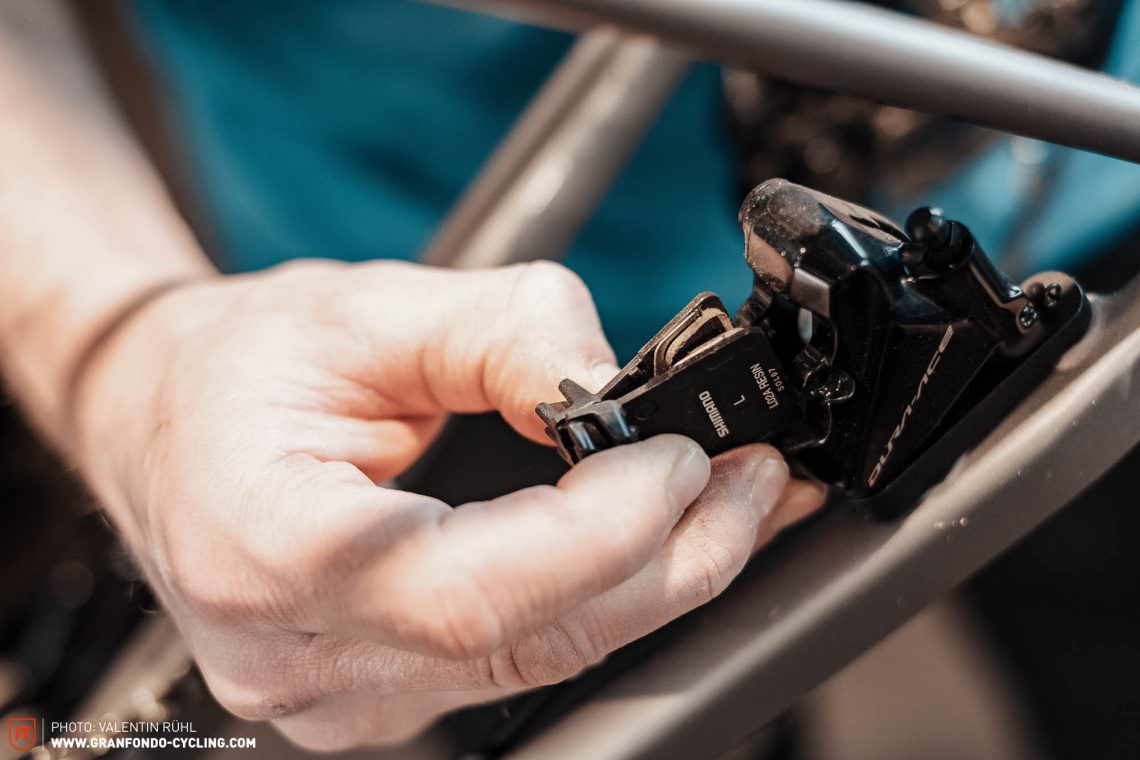
Example sum
Wear and tear depends heavily on personal use and riding habits. The following calculation is based on our experience and is what you would expect as a competitive gravel rider who mainly rides longer routes about twice a week. The annual mileage of our example rider is 3,000 km, which may sound like a lot but isn’t uncommon for someone who rides frequently. The prices are those we found in the biggest online shops and are based on components at Shimano GRX level. We assume that most repairs will be carried out by yourself and that you already have all the tools for the job. You will find a lot of tips and tricks for the home bike mechanic in our know-how section.
| Part | Quantity | Price | Total price |
|---|---|---|---|
| Chain | 2 | € 20 | € 40 |
| Cassette | 1 | € 80 | € 80 |
| Chainring | 1 | € 50 | € 50 |
| Brake pads | 2 | € 15 | € 30 |
| Brake rotors | 2 | € 30 | € 60 |
| Tires | 2 | € 40 | € 80 |
| € 340 |

How do I protect my gravel bike from theft?
Protecting yourself against thieves is mandatory and physical deterrents such as locks are just as important as where you choose to park your bike. Together with the security technology experts at ABUS, we’ve written an in-depth article on theft protection for our sister magazine E-MOUNTAINBIKE. For additional peace of mind, it might be worth considering a GPS tracking solution such as the PowUnity BikeTrax, which won the Design & Innovation Award. However, the BikeTrax requires a power supply, meaning it can only be used with an E-gravel bike.

Materials, drivetrains, tires – part two of our guide is all about the bike itself and the technology on it. What is useful, what is superfluous, what options are even out there? Even if the frame and geometry have the biggest influence on how a bike handles, the components are decisive when it comes to how much you can enjoy the ride or, in the worst case, if you can ride certain terrain at all. Are you looking for the perfect gravel bike but don’t know exactly what you need? Then you’ve come to the right place.
Which pedals are the right choice for your gravel bike?
Black or white? Good or bad? McDonald’s or Burger King? Questions of faith that you also have to deal with in the world of gravel bikes. One of these is the choice between flat and clipless pedals. Will you only touch the ground with your feet when you stop at a traffic light or do you plan to use the bike to get from A to B and then continue walking on? In the first case, clipless pedals and cycling shoes with cleats make sense as the system enables significantly better power transfer, a rounder pedal stroke and a secure pedalling position on rough terrain. Anyone with a background in road riding will most likely be used to riding with clickies anyway, so the question comes down to which clipless system to use on a gravel bike. Road bike cleats and shoes make little sense on gravel bikes. Designed for maximum stiffness and power transmission, the soles of these shoes are typically made of carbon, which is far too sensitive for gravel terrain and offers no grip when you have to get off and push. Shimano’s SPD system, ostensibly for mountain bikes, makes much more sense for use on a gravel bike and the choice of pedals and shoes available is huge. If you want a bigger contact surface for your shoes and protection for the clipless mechanism, you’ll do well to get a pair of pedals with a cage, though models without a cage should do the job in most cases. In addition to the SPD system, which reaches its limits in muddy conditions, Crankbrothers’ design offers better self-cleaning properties.
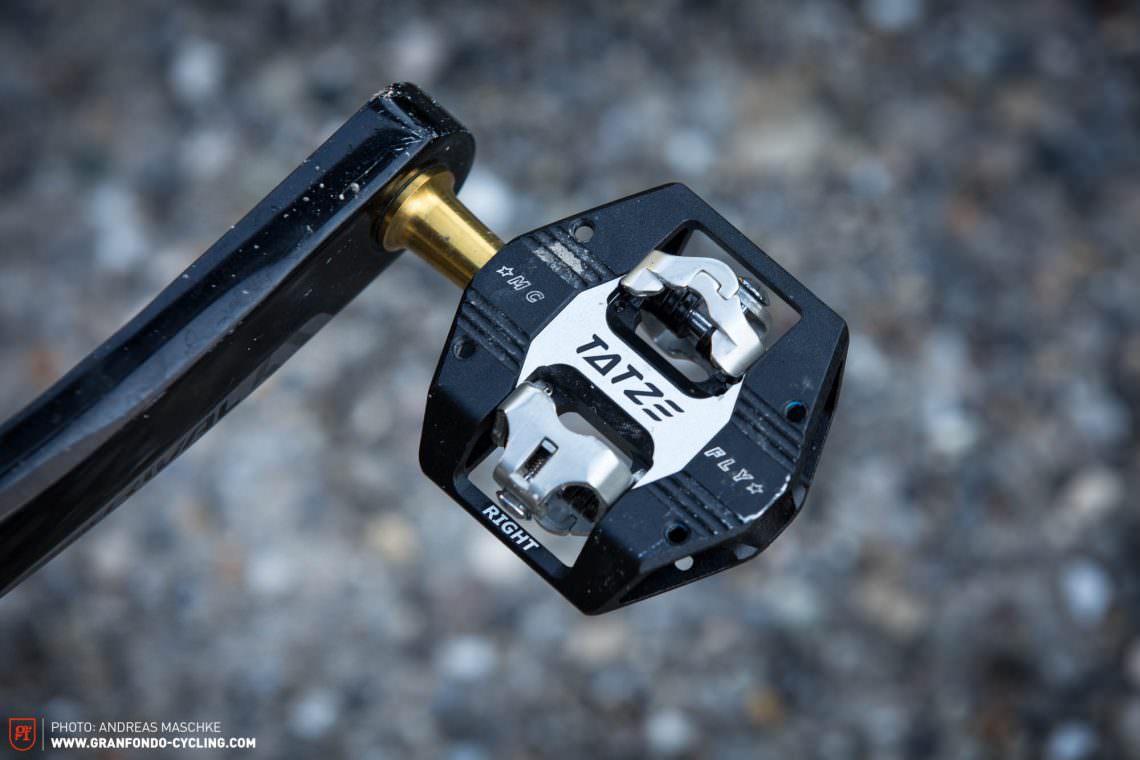
If you often travel from A to B and then walk without changing shoes, we recommend using flat pedals. Though you’ll find that some clipless shoes are better to walk in than others, none of them are made for walking long distances or on hard surfaces. In this case, you’ll be much better off in a pair of trainers. The selection of flat pedals ranges from models with long metal pins for optimal grip in rough terrain and on the trails to less aggressive pedals for urban commuters. For an in-depth look at what’s available, check out our group test of the most popular mountain bike pedals in our sister magazine ENDURO (available here).
Tube or sealant – Does going tubeless make sense on a gravel bike?
Before we get into wheel sizes and tires, let’s briefly address a concern that many of you might have. Almost all gravel bike tires and rims currently available are tubeless ready and we strongly recommend making the most of that. The advantages of tubeless clearly outweigh any of the downsides: improved puncture protection, more compliant tires and thus improved grip as well as a slightly lower rotating mass. As we found out in the lab during our gravel tire group test (available here), replacing the tube with sealant reduces the tire’s rolling resistance by about 10%. The only downside is that you’ll need to carry a spare tube instead of just patches in case you puncture your tire so badly that the sealant can’t fix it. Depending on the tire and the extent of the damage, normal tire plugs (MaXalami or Dynaplug are just two examples) can also do the trick. Besides that, you’ll regularly have to check how much sealant you’ve still got in the tire as it evaporates and dries up over time due to heat, oxygen and mechanical influences. For a deeper look into the subject and to find out everything you need to know about tubeless systems, we’ve published a detailed tubeless guide!.
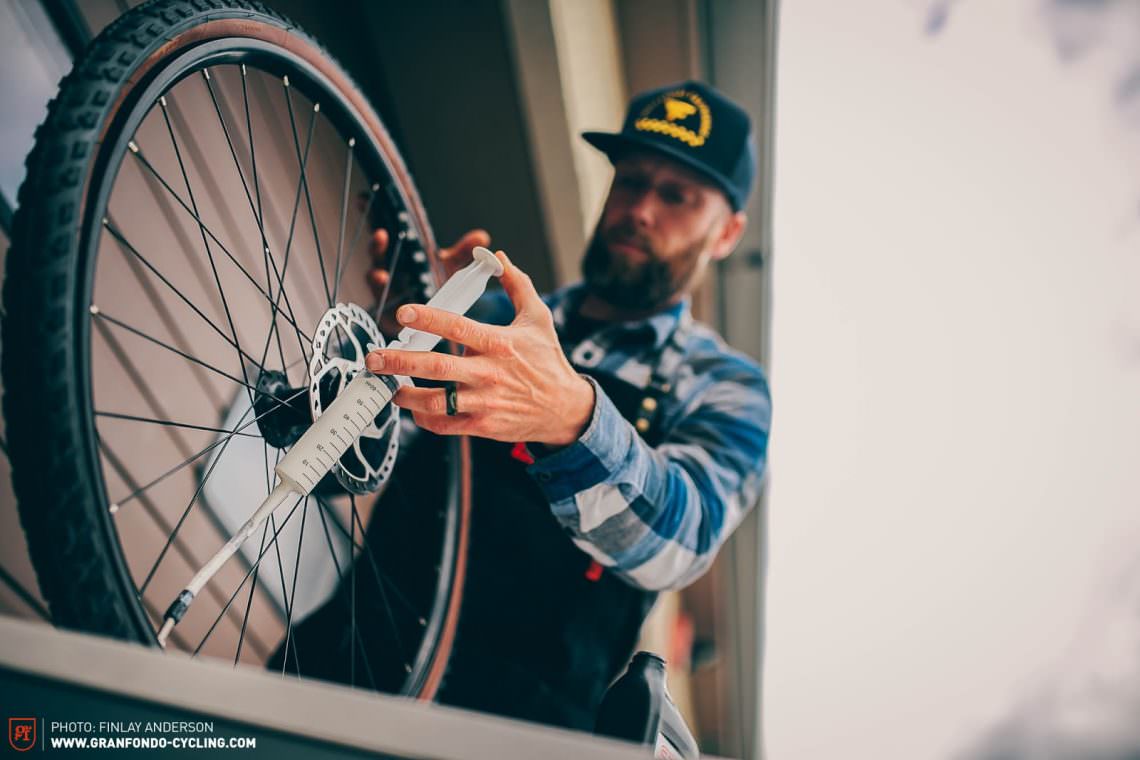
What wheel size and tire concepts are there for the gravel bike?
In most cases, the tire concept is the basis for the geometry, handling and, above all, the gravel bike’s intended use. You can divide the market into roughly three different categories, some of which differ greatly in speed, grip and comfort. Exceptions are brands such as Compass Cycles and WTB, whose gravel/all-road portfolios cover the entire spectrum, offering options in each.
700C
This is the classic road bike size and can be found on the majority of gravel bikes, usually between 35 and 42 mm wide, or even wider in some exceptional cases, and almost always with a bit of tread. Compared to traditional cyclocross tires, the tread of gravel tires isn’t nearly as deep and aggressive, usually consisting of flat diamond-file patterns or ridges and the central profile often differs from that on the shoulders. 700C tires tend to have low rolling resistance, offering good acceleration on asphalt and manoeuvrability through corners. They are typically ridden with air pressures between 2.3 and 4 bar, depending on width and terrain. Examples include the Panaracer GravelKing (read review), Schwalbe G-One Bite (read review) or WTB Riddler (read review). Our gravel tire group test (available here) tells you which 700C all-round gravel tire is the best. It’s worth taking a look at! Experience has shown a tire width between 40 and 45 mm to be the ideal compromise.
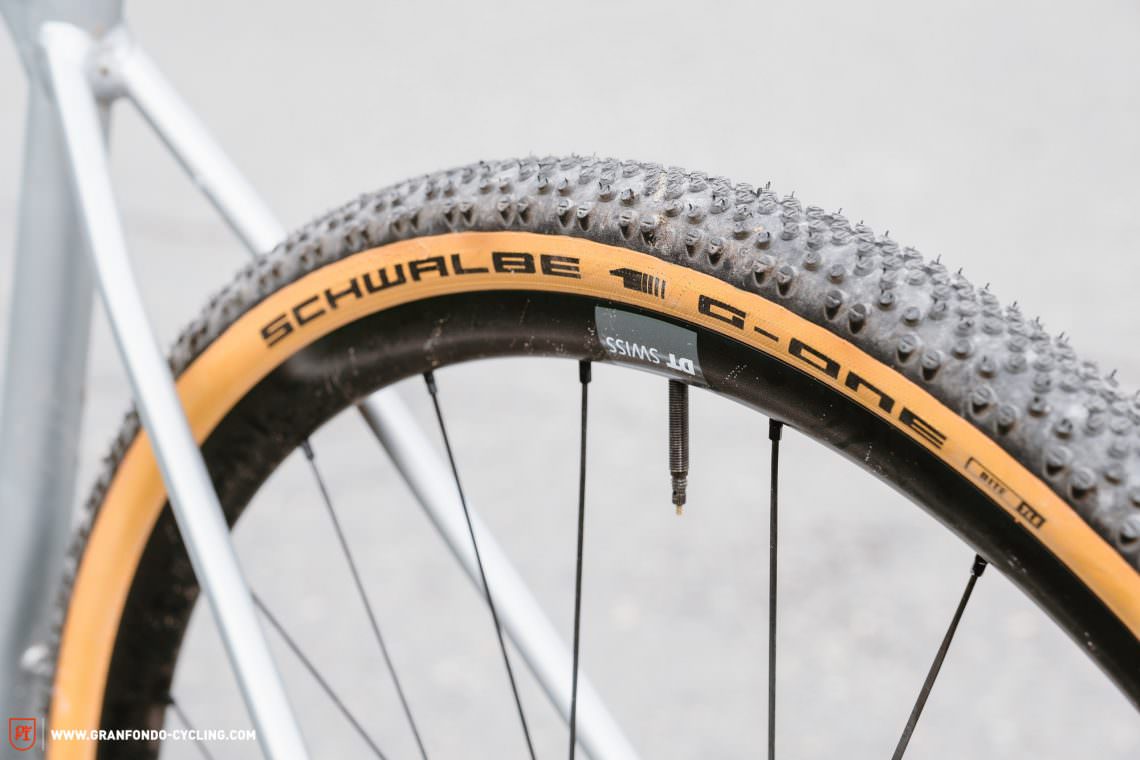
650B
The market for 650B tires is growing steadily and several tires that were previously reserved for the 700C market have now been made available in 650B. The maximum width of 700C tires is where 650B really gets going. For example, the Schwalbe G-One Bite is available in an extra-wide 650 x 54B version. Compared to narrower models, tires with a width of 40 mm or more offer improved comfort and grip as they can be ridden at lower pressures and provide a larger contact patch on the ground. It’s no surprise that four of the bikes in our bikepacking bike group test (available here) were specced with 650B wheels and tires – in bikepacking, comfort takes precedence over maximum speed and performance. If you’re toying with trying a tire of this size, be sure to measure the clearances of your frame and fork beforehand and keep in mind that you’ll need to leave some space for mud and dirt to clear. You’ll also have to check whether your rim is suitable for the desired tire width. You’ll find a clear table with practical information on rim widths, tire widths and tire pressures on DT Swiss’’ website (PDF available here).
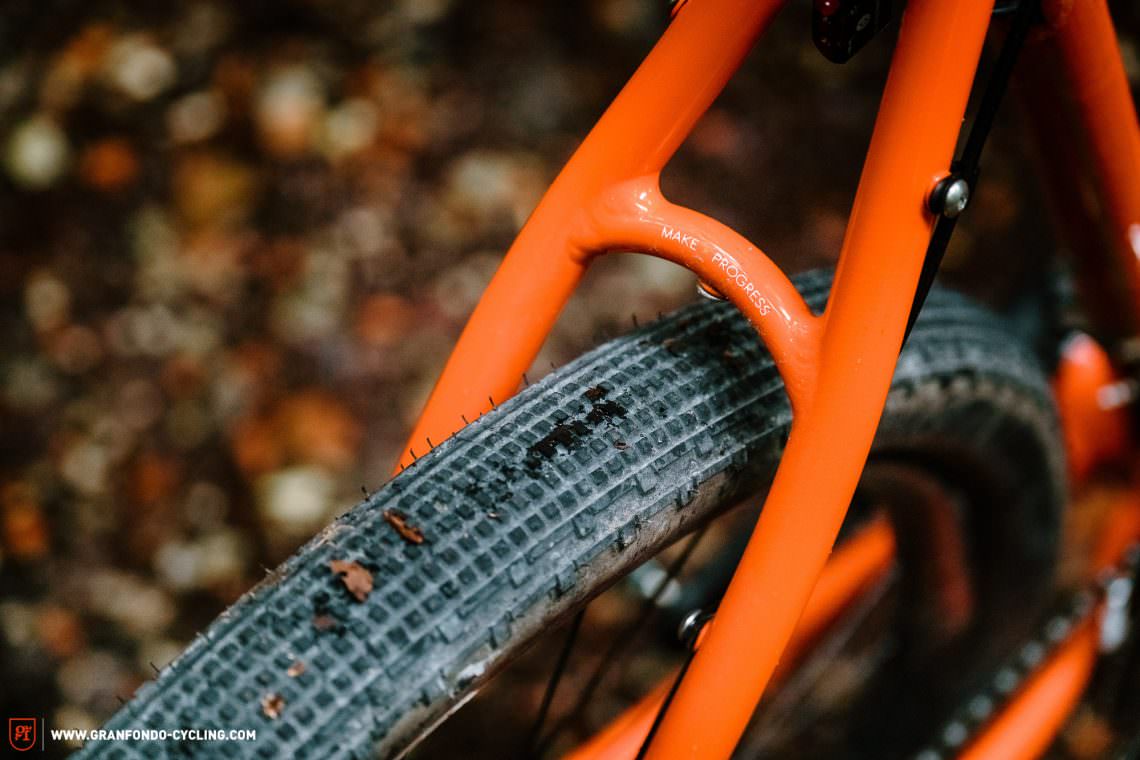
650B (semi-)slicks
Often referred to as “Road Plus”, these tires come with little or no tread in widths ranging from 42 to 50 mm. There aren’t many bikes on the market specifically designed for this size. The casings of these tires often have a high thread count (TPI) and together with their high volume, this allows them to easily conform to the terrain. The high volume and correspondingly low air pressure offer excellent vibration and bump absorption, which, along with a wider contact patch, reduce rolling resistance compared to a narrower tire. They offer a very high level of comfort on poorly maintained asphalt and gravel but less grip in muddy conditions or on (damp) grass than skinnier 700C tires which are able to ‘cut’ through the soft layers of the ground. They’re typically run at pressures of 2 to 3 bar and are very sensitive to small changes in pressure. The ideal pressure for asphalt is usually too high for gravel and the appropriate air pressure for gravel is often too low for pedalling out of the saddle on tar. With these tires, it’s best to adjust the pressure to the surface while riding to find the ideal pressure for the best performance. Like the bikes, the market for tires in this category is limited. Some of which come to mind are the Compass Switchback Hill TC, the Teravail Rampart and WTB’s Byway and Horizon.
29”/ 27.5” off-road
With a few exceptions, these tires are identical to the ones you’ll find on marathon or XC mountain bikes, their widths usually ranging between 1.9 and 2.2″, or 48 and 56 mm, and even wider in some exceptional cases. Their profile, weight and puncture protection are low for mountain bike standards but they can increase the off-road capabilities of a gravel bike significantly. However, that comes at the cost of speed and rolling resistance on compact surfaces. Bikes with these tires are typically geared towards adventure, offering maximum speed, comfort and safety on off-road terrain. The Schwalbe Thunder Burt, the WTB Nano or the MAXXIS IKON are common choices for this category. Two bikes we recently tested are the RONDO BOGAN (read review) rolling on 700 x 53C tires and the Salsa Cutthroat GRX 600 (read review) specced with 700 x 56C rubber.
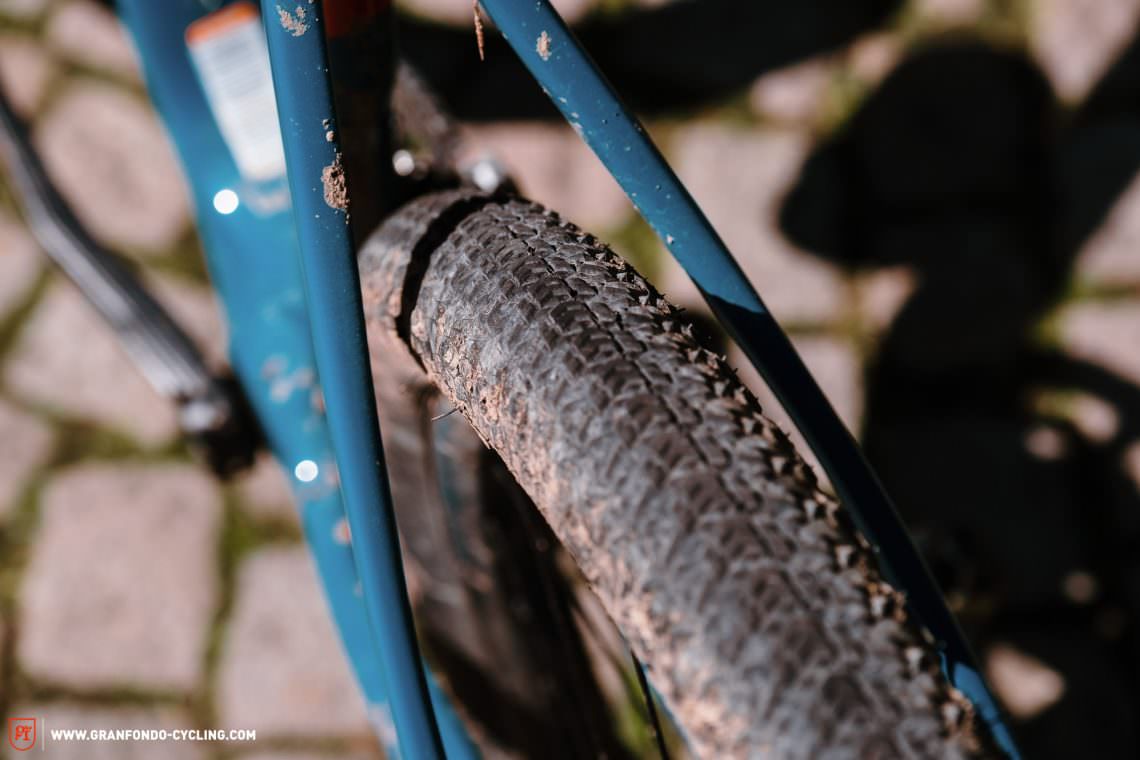
What is the perfect gravel bike drivetrain? 1x, 2x, mechanical or electronic?
If you take a look at the test field of our latest gravel bike group test, you can immediately see that 1x drivetrains have established themselves in the gravel sector with only a few bikes equipped with 2x groupsets. There’s no getting around electronic shifting either, at least on the flagship models. Below, you will find a breakdown of all the options, their advantages and disadvantages as well as examples and intended uses of each.
1x
Single chainrings up front have rightly become the norm on mountain bikes and the majority of gravel bikes are following suit. With cassettes offering gear ranges of up to 520% (currently only available for the wireless SRAM AXS groupset) they offer a range similar to that of a compact 2x drivetrain and make shifting a whole easier in technical terrain. This system also requires less maintenance, has fewer parts that wear, weighs less and as a result is less susceptible to defects. However, this drivetrain has one disadvantage: the gear jumps are significantly bigger with a huge 10–52 t cassette than with groupsets that rely on two chainrings and a smaller cassette.

2x
The classic drivetrain with two chainrings and a small cassette also deserves its place in the world of gravel bikes. The smaller gear steps are particularly useful on bikes that get ridden on asphalt at least 50% of the time. In principle, you could use the same drivetrain setups that you find on road bikes. However, we strongly recommend a compact crank and preferably a 32 t cassette. The disadvantages of 2x drivetrains are the increased shifting frequency, a little more maintenance and less reliability when shifting from one chainring to another in rough terrain. In addition, some frames are designed for maximum tire clearance and thus completely dispense with a front derailleur mount. Classified’s recently launched gear hub simulates a 2×11 speed drivetrain without a front derailleur – the perfect groupset for gravel bikes? We’ve already put it to the test (read the Classified review).

Electronic vs mechanical shifting
One of the biggest findings of the last gravel bike group test is that electronic shifting is here to stay and that there is no getting around groupsets without a shifter cable in this day and age! After endless kilometres on bikes with electronic drivetrains, we can assure you that reliability and robustness aren’t an issue and that they make shifting super easy and convenient. However, you do have to remember to charge the batteries. With Shimano, you can simply plug in your power bank and even charge the system while riding; for SRAM’s eTap groupsets, the battery has to be plugged into a separate charger.
Frame materials – Heavy metal or CFRP?
Gravel bikes come in all common frame materials. However, aluminium is relatively rare and the majority of the bikes available rely on carbon or steel. Some manufacturers also offer the same model in several different materials. Titanium frames can only be found in the high-end segment and are often only available as a frameset or made to measure. So, what are the advantages and disadvantages of each material?
Aluminium
For the most part, aluminium frames are very cost-effective to produce. Although they’re not as light as carbon, they are just as stiff. Uncompromising stiffness may be an advantage in the road and CX segment but damping properties and a certain level of riding comfort are important when gravelling. Our last bikepacking bike group test (available here) showed that gravel bikes made of aluminium are too stiff to generate sufficient comfort – examples include the Canyon Grail AL (read review) and Mason Bokeh (read review). However, in combination with a carbon fork, they can still be a lot of fun without breaking the bank. Like every material, the technology around aluminium is constantly being refined and improved thanks to new alloys and innovative manufacturing processes. Some modern aluminium frames can be better than a cheaper or ten-year-old carbon frame.
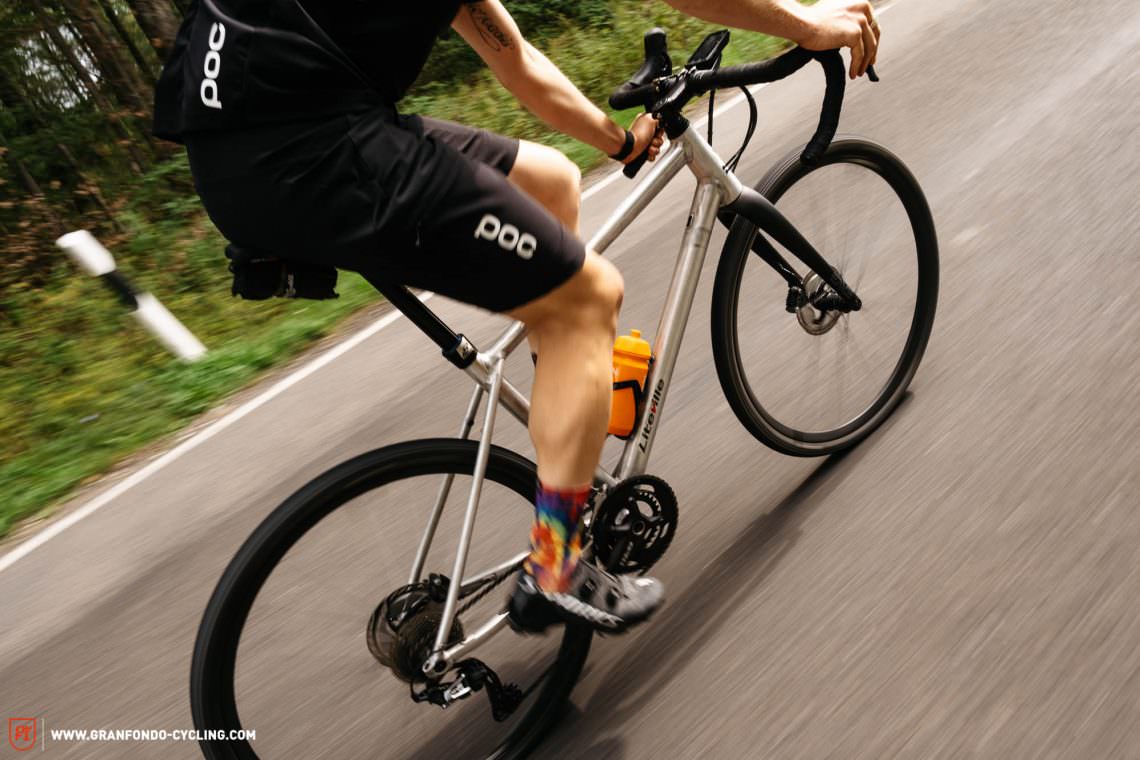
Carbon
Gravel bikes made of carbon can be built very stiff yet also the lightest. Furthermore, the layup of the CFRP makes it possible to tune material properties to fulfil specific requirements on different areas of the frame. For example, the area around the bottom bracket can be made to be very stiff while the seat stays are allowed to flex. In addition, carbon makes it much easier to offer special features like big tire clearances by allowing the implementation of elaborate designs such as dropped chainstays. The disadvantages of carbon frames are their susceptibility to damage and potentially invisible defects. The riding comfort is also heavily dependent on the layup of the frame and a lot of know-how is required to surpass the damping qualities of a good steel or titanium frame. Just because a frame is made of carbon doesn’t necessarily mean it is good or appropriate for the intended use.
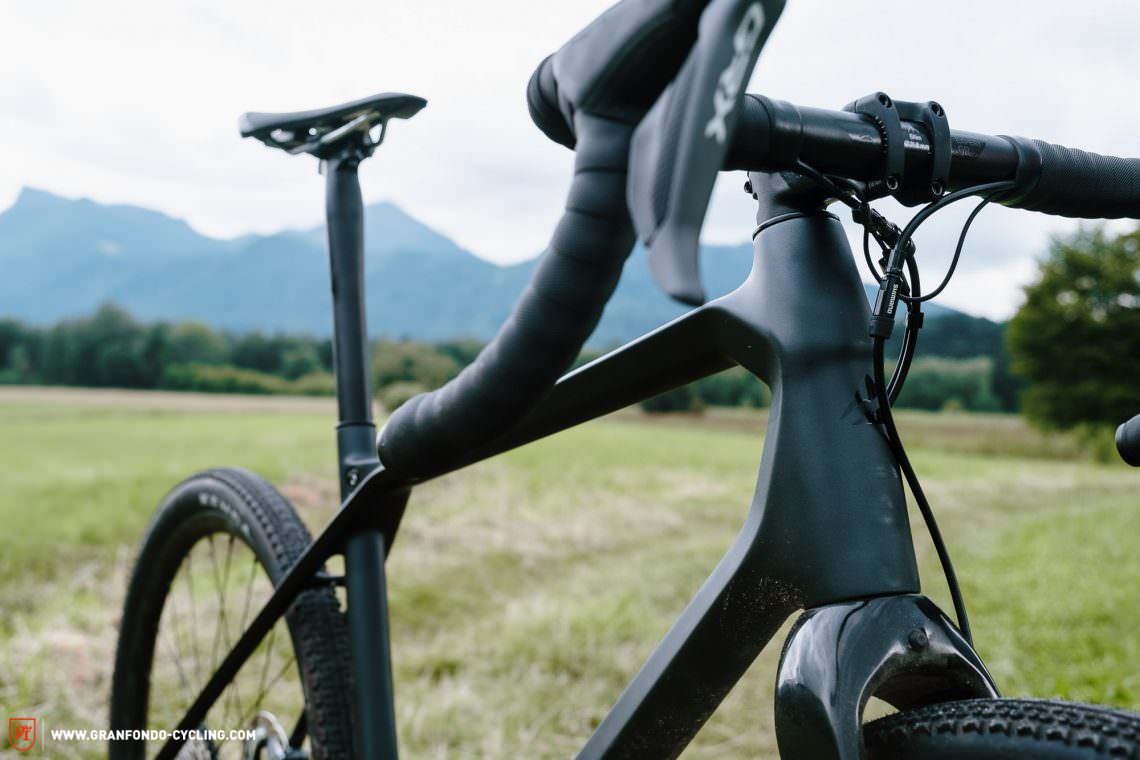
Steel
Steel is a very multifaceted and, above all, tough material. However, its damping properties, weight, robustness and stiffness is hugely dependent on the tubeset selection. From cheap, robust but heavy CrMo gas pipe to the ultra-thin, premium but also super-expensive Reynolds 953 or Columbus XCr, you’ll find something to suit every budget and purpose. Bigger manufacturers typically rely on more robust and somewhat heavier tubes for complete bikes – therefore mostly bikes designed for adventure and high volume off-road tires. High-end tubing is reserved for select custom built frames or framesets.
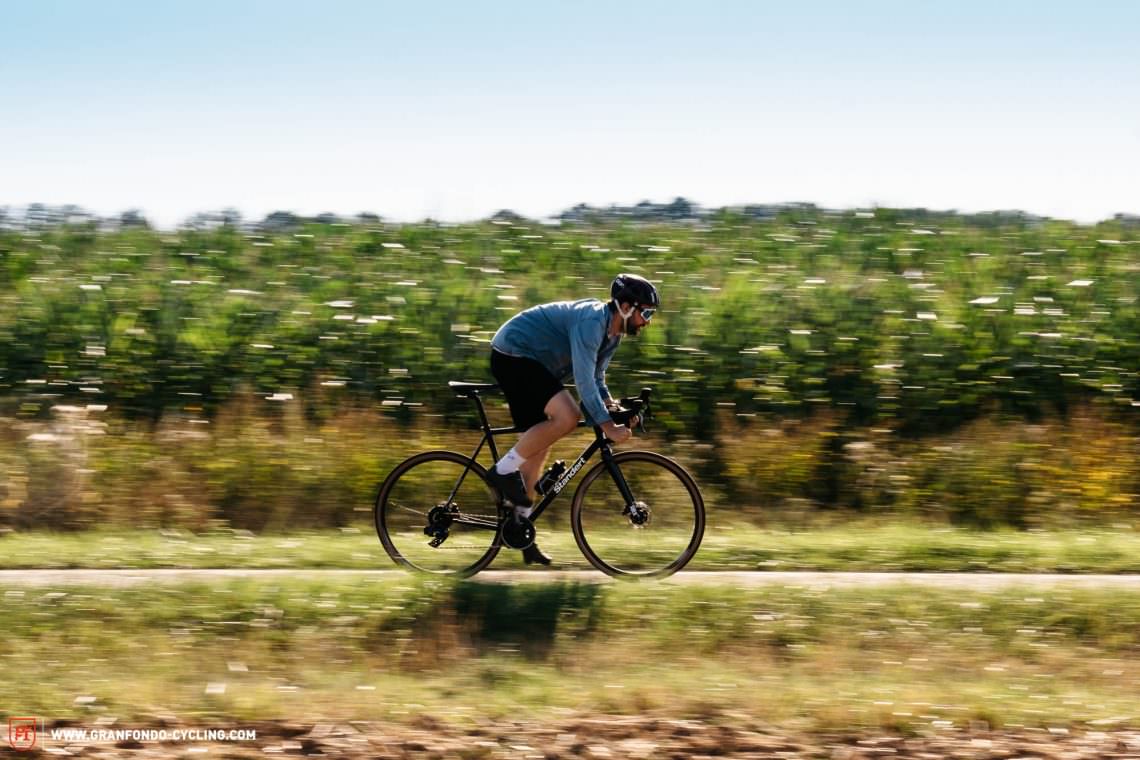
Titanium
Titanium is usually the most expensive frame material but it’s got the looks to match and has some unique properties that make it very desirable. It’s lighter than steel but just as robust and offers even better damping while being completely resistant to corrosion. There are some complete bikes made of this precious material but it’s most common on framesets or custom frames.
What is the best material for a gravel fork?
The fork has a significant impact on handling, comfort and safety of the bike. Since complete bikes and most framesets already come with a suitable fork, this chapter is mainly applicable to custom builds and upgrades. With a new fork, you can dramatically change the feeling of a bike and it requires in-depth knowledge about geometry and its effect on the bike’s handling. If you’re not clued up but still want to swap the fork, for example for one with bottle cage mounts, you should make sure that the axle to crown length, rake and tire clearance are as close as possible to the original fork. Like the frame itself, forks are available in various materials.
Aluminium
Aluminium forks are the cheapest option for an upgrade. However, due to their poor damping properties and heft, they only make sense if you want to increase tire clearance, change the handling of a low-end bike or for special features such as bottle cages or fender mounts. Since almost all stock bikes currently on the market come equipped with carbon forks, your aftermarket aluminium options are rather limited.
Carbon
Carbon forks offer the most tuning potential. The aftermarket options in this segment cover all conceivable geometries and features so that everyone should find just what they’re looking for. Warning: stay away from carbon forks with aluminium steerer tubes! They’re temptingly cheap but usually of inferior quality. Constructed this way, they offer poor damping and are usually only slightly lighter than a model made entirely of aluminium.
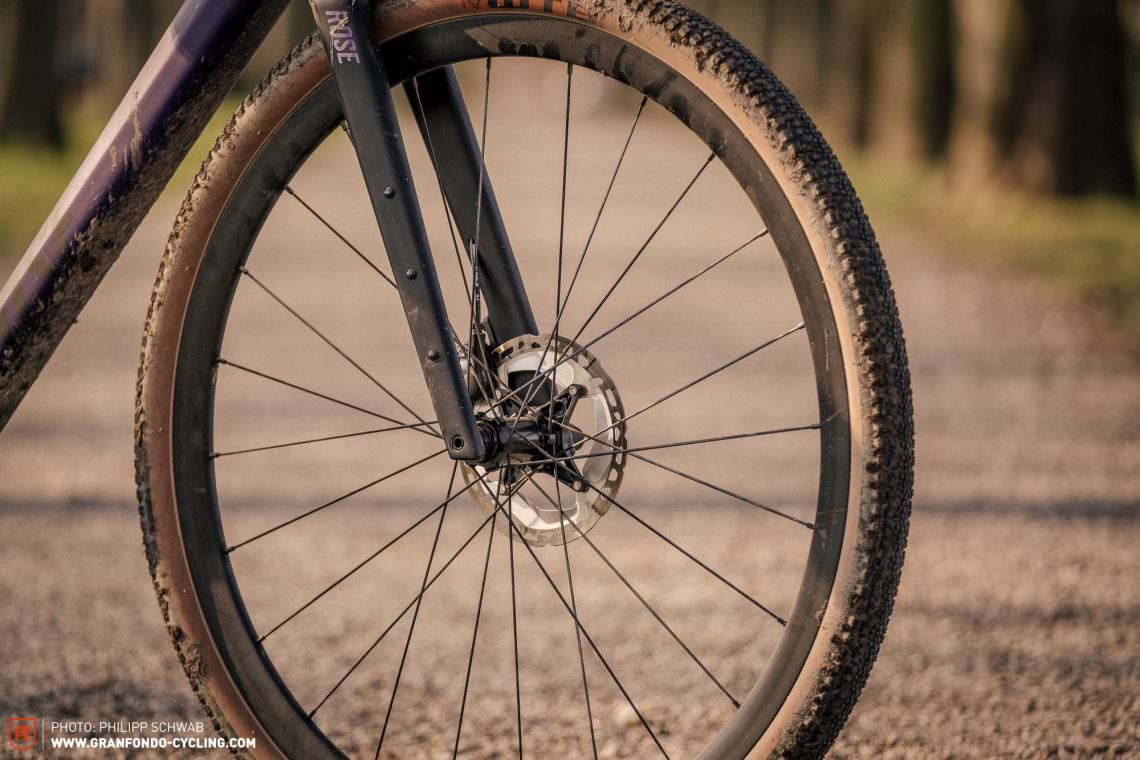
Steel
Steel forks are on average at least twice as heavy as comparable models made of carbon. Nevertheless, they have some unique features to offer. Depending on the tube set used and the way they’re constructed, they can offer excellent damping while still being very stiff laterally. In addition, they protect the frame if you crash into something head-on (giving way before the frame does) and can also be straightened in case of minor deformations. Aftermarket steel forks are largely designed to be robust and offer features such as triple-cage mounts or eyelets for luggage racks and mudguards. If you’re worried about weight, require specific geometry or have any special requests, you’ll find what you’re looking for at your trusted frame builder – and you’ll often pay less than for a high-end carbon model.
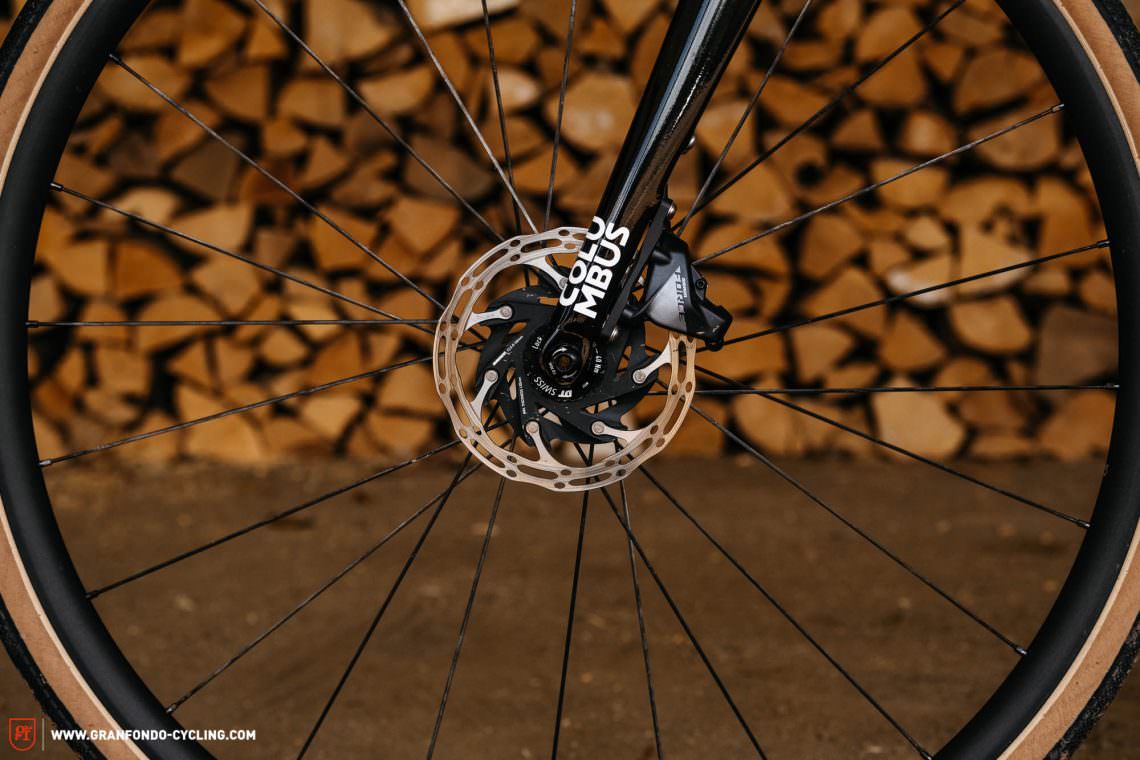
Titanium
Titanium forks offer the most comfort. Their damping properties are almost unbeatable, they weigh less than their steel counterparts and thanks to the inherent properties of the material, they are arguably the most durable and toughest forks on the market. Unfortunately, they’re also the most expensive. Besides the considerable costs of the material itself, the aftermarket range is very limited and you’ll usually have to go to a frame builder who can work with titanium.
Suspension forks also make for an exciting aftermarket gravel bike upgrade. They range from various kinds of classic telescoping suspension forks to undamped leaf spring constructions. More on this later in our section on suspension.
How important are aerodynamics on a gravel bike?
What we discovered at the beginning of 2020 still holds true: aero is everything, but not on a gravel bike. There are some bikes with aerodynamic features but the real sources of wind resistance are the frontal surfaces of the 700 x 40C tires, the turbulence caused by aggressive tread, externally routed cables and the typically more upright riding position. So, don’t worry too much about aerodynamic optimisation and enjoy the fresh breeze blowing through your flannel shirt instead!
Which handlebars make sense on a gravel bike?
As we’ve already mentioned, there are no rules for gravel bikes and you can’t put them into any drawer. Rather, they are as difficult to pin down as Optimus Prime, not only available with different wheel sizes and various groupset configurations but also with different handlebars. Even if most gravel bikes come equipped with drop handlebars, flat mountain bike handlebars also deserve their place.
Road bike handlebar (drop bar)
Gravel bikes usually don’t get ridden much on perfectly tarred roads. As a result, factors such as aerodynamics and weight play a subordinate role with control and comfort taking precedence. The market has responded very quickly, offering a large number of suitable handlebars. Most of them have a more or less pronounced flare with the drops curving slightly outwards. This means that your hands are positioned wider apart in the drops than on the hoods. The resulting wider grip position gives you more control of the bike in technical terrain, giving you more confidence. For the same reason, most gravel bike handlebars are slightly wider than those found on standard road bikes. The drop, reach, damping, stiffness and also shape of the handlebar vary greatly from one product to the next and you’ll have to experiment to find out what works for you. Opinions are just as divided when it comes to the material: carbon handlebars usually offer better damping but they can also reduce control if they flex too much and are usually a bit more delicate. Aluminium handlebars are cheaper, less susceptible to damage but also offer less damping. Common gravel handlebars include the Easton EC70 AX, Ritchey WCS Butano, Ritchey WCS Carbon VentureMax and Acros Gravel Bar.

Mountain bike handlebars (flat bar)
For some, a mountain bike handlebar can be a sensible alternative to the more widespread drop bars. The advantages are manifold: on the one hand, a flat bar offers more space for handlebar bags. On the other hand, the rider has more control of the bike in the rough and on descents, offering a very secure grip for your hands with the brakes always within easy reach. In addition, a flat bar allows you to use mountain bike-specific components on your gravel bike for things such as the brakes and shifters. Examples of gravel bikes that also come in versions with flat handlebars as standard are the Norco Search XR (read review) – the flat bar version is called the Norco Search XR Flat Bar – and the ROSE BACKROAD (read review) – the flat bar model is called the ROSE BACKROAD MULTICROSS.
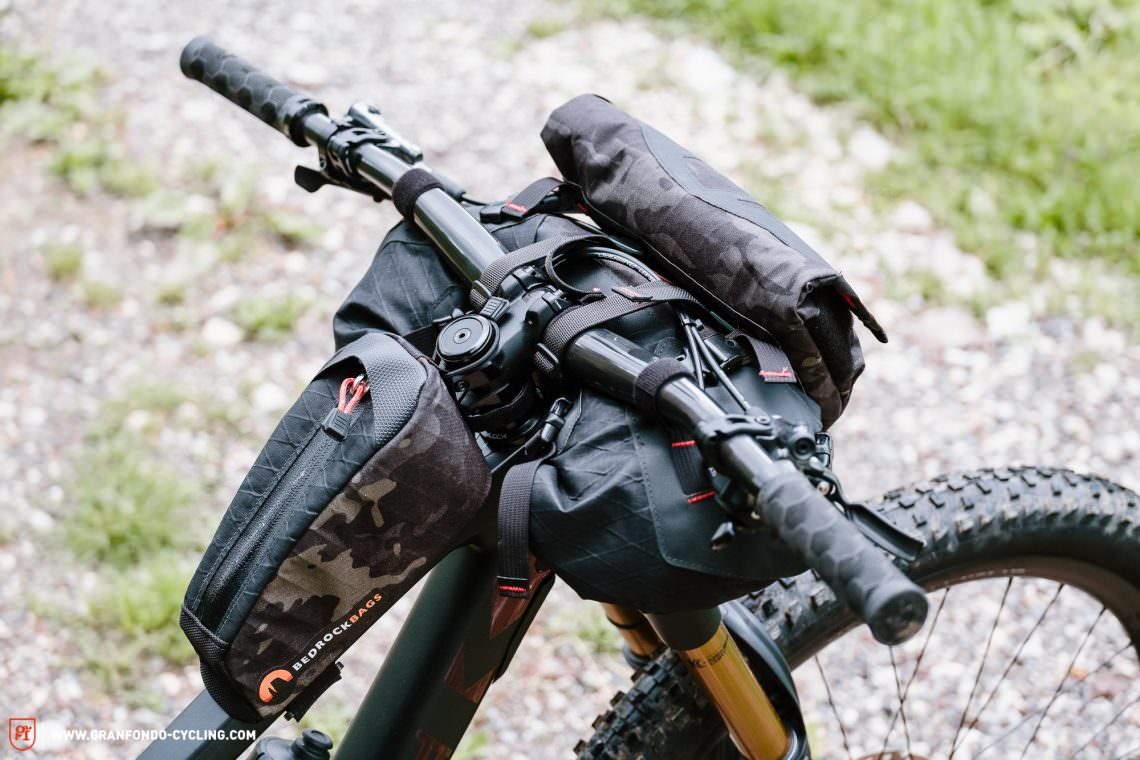
The best brakes for a gravel bike
You’ll be hard-pressed to find a gravel bike that doesn’t rely on disc brakes as their advantages easily outweigh any downsides. Braking power, modulation and reliability are just three points that speak in favour of discs on a gravel bike. In most cases, the disc brakes are operated hydraulically with only a few exceptions such as the RONDO BOGAN (read review) with mechanically operated brakes. However, the modulation and ultimate power of mechanical disc brakes can’t hold a candle to the performance of hydraulic models. It is not only important to have the right brakes but also to choose the correct size rotors for the intended purpose. In any case, the front and rear should measure at least 160 mm in diameter. On bikepacking trips with a loaded bike, you’ll do well with a 180 mm model up front.
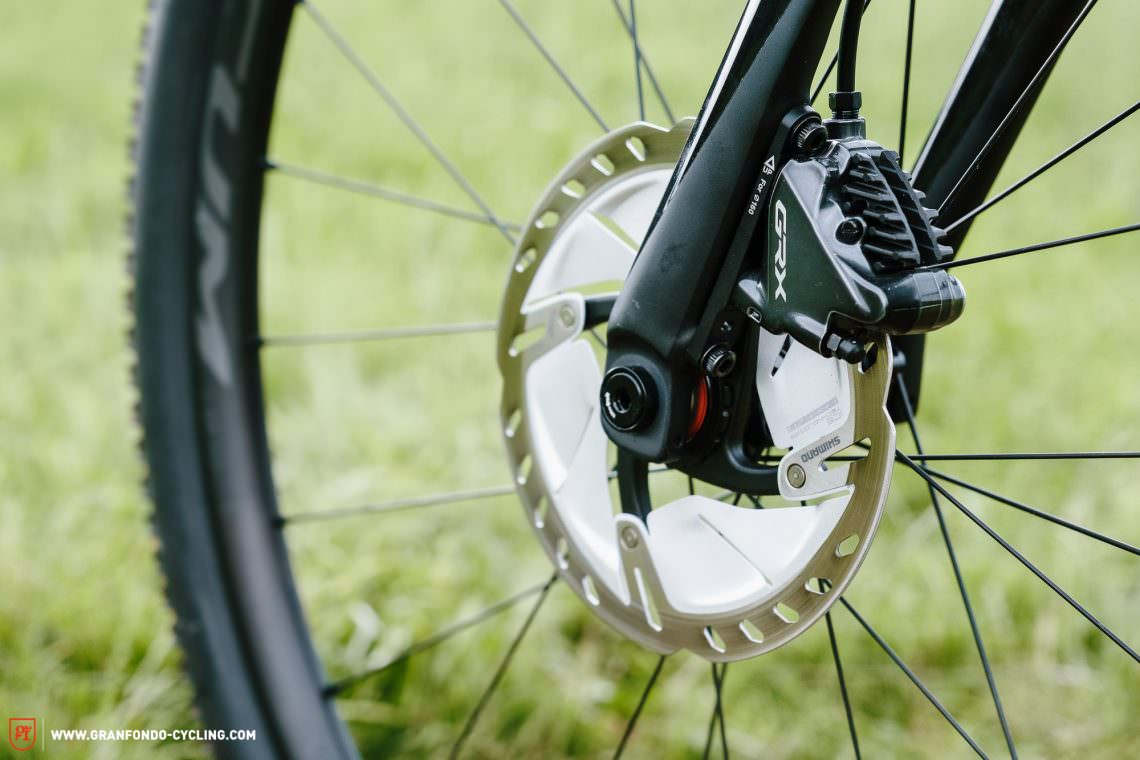
Gravel bike seatposts – Classic, suspended or a dropper?
Carbon seat posts
Similar to the handlebars, comfort plays an important role. The core benefit of carbon seatpost is its ability to provide vibration damping or even impact absorption. However, not every carbon seatpost is made equal. Models specifically designed for compliance and comfort will have a special carbon layup, some even consisting of several distinct parts to offer increased flex. Usually, this means that the seat post can flex backwards on impact, depending on how far it’s extended of course. The additional comfort this provides is not to be sniffed at, especially on long rides and in rough terrain. Most complete bikes in the higher-priced segment have seat posts like this, often supplied by the manufacturer’s in-house brand. Some examples of aftermarket models are the Ergon CF3 Pro, Ritchey WCS Carbon Link Flexlogic or Syntace P6 Carbon HiFlex.
Aluminium seat posts
If you plan to ride with a large saddlebag strapped to the seat post the majority of the time, you should opt for an aluminium model despite their harsher ride quality. The additional weight of the saddlebag is likely to negate the benefits of a compliant carbon post and the effects of the bag rubbing against the seatpost shouldn’t be underestimated, especially in combination with mud or dust. There are plenty of reliable aluminium seat posts on the market, including models from brands such as Thomson, Tune or Syntace. Suspended seat posts are another option, but more on this in “Suspension on gravel bikes”.
Dropper posts
The more you ride your gravel bike off-road, the more useful a dropper post becomes. Getting the saddle out of the way, even if it’s just 40 to 70 mm lower, will allow you to tackle technical descents with a lot more confidence and control – dropper posts have become indispensable on mountain bikes. A lot of the most recent gravel frames come with stealth cable routing for a dropper post, allowing cables to be routed internally. The disadvantages are the price, weight and lack of compliance. Bikes that come with a dropper post off the shelf include the Fustle Causeway GR1 (read review), Norco Search XR C2 (read review), Marin Headlands 2 (read review), Evil Chamois Hagar (read review) and Specialized S-Works Diverge (read review).

Gravel bike suspension – What options are there?
When it comes to damping, things don’t end at high-volume tires and special carbon cockpits. In addition to suspended seat posts and telescoping suspension forks like you can find on mountain bikes, some frames are built with integrated damping mechanisms. We’ve compiled an overview of all the systems for you here.
Gravel bike suspension forks
A suspension fork on a bike with drop bars? Though it sounds strange at first and looks strange too, it makes perfect sense for some riders. With a rigid fork, you risk suddenly losing control on roots, rocks, compressions and ruts, where a suspension fork would effectively defuse the impact and keep everything stable and composed. The best-known gravel suspension fork is the Cannondale Lefty, which we’ve already put to the test on gravel roads and trails in our reviews of the Cannondale Topstone Carbon Lefty 1 (read review) and the Cannondale Topstone Carbon Neo Lefty 1 E-gravel bike (read review). Other suspension forks for gravel bikes include the FOX 32 AX and Lauf Grit (read review).

Suspended seatposts
Suspended seatposts offer increased comfort and relief for your back on gravel slopes. Unlike carbon seatposts, they’re not affected by extension length. The parallelogram damping system on the EeSilk from Cane Creek (read review) effectively absorbs small hits and continuous vibrations. If you tend to head further off-road into rougher terrain and want maximum comfort, you should take a closer look at the ShockStop seatpost from Redshift (read review). Due to the effect this might have on your riding position, we definitely recommend taking it for a test ride first.
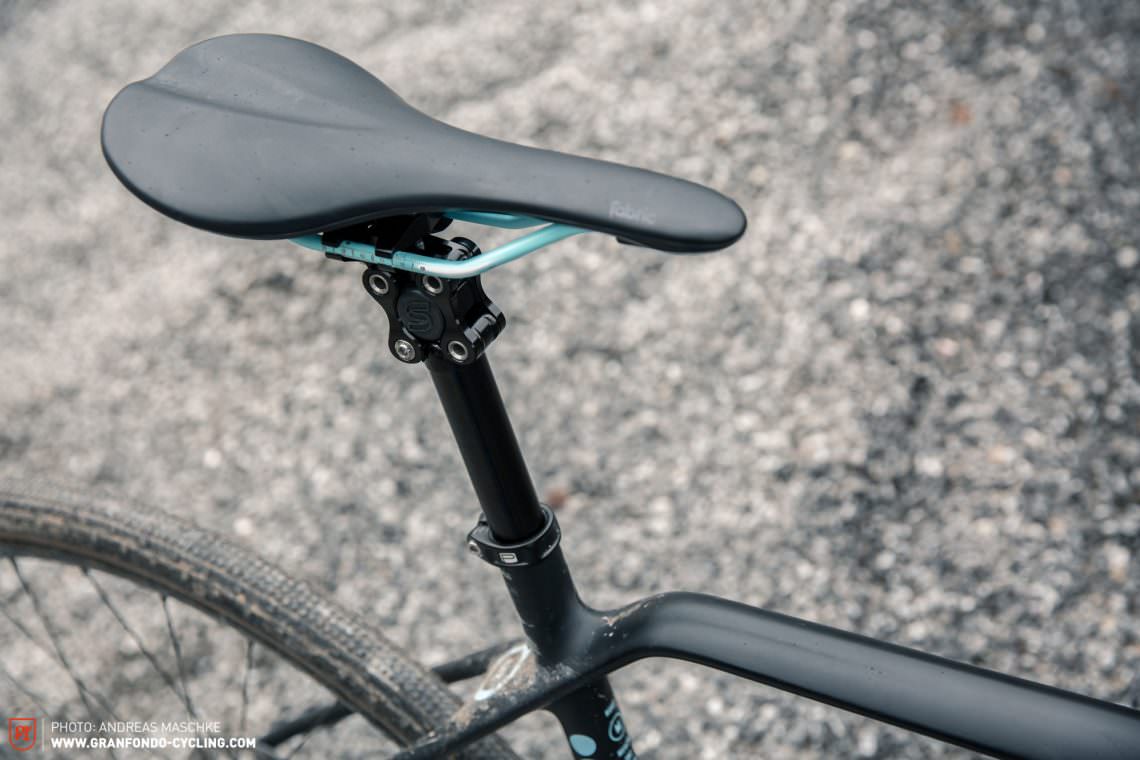
Suspended stems
Admittedly, the market for suspended stems isn’t big. The Redshift ShockStop stem (read review) is the counterpart to the ShockStop parallelogram seatpost on the rear and performed convincingly in our review. If you’re looking for more cushioning for your hands and arms and haven’t been able to achieve the desired result with your tires, fork and handlebar, a suspended stem may be a good option for you.
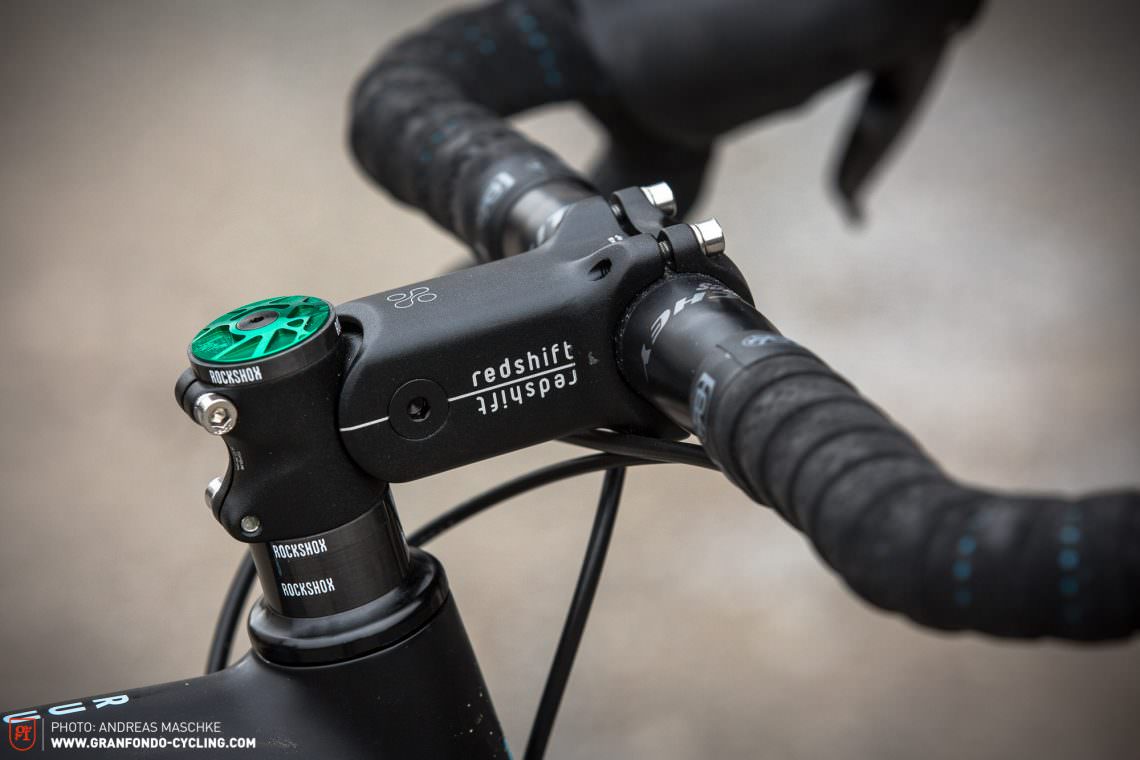
Integrated concepts for more comfort
There are several brands currently on the market that have integrated a damping system into their frames. Unlike a suspension fork, it’s only the rider that’s suspended with the frame acting as the damper. One advantage of these systems is that they do not influence the drivetrain and handling of the bike. Specialized’s proprietary Future Shock 2.0 system has long featured on their Diverge (read review of the Specialized S-Works Diverge) and Roubaix (read review of the Specialized S -Works Roubaix SRAM RED eTap AXS) platforms, which offers 20 mm of adjustable travel between the stem and top tube. An alternative approach is Cannondale’s KingPin system as featured on the Cannondale Topstone Carbon Lefty 1 (read review). The seat stays can pivot on the seat tube and, according to the manufacturer, allow up to 30 mm of travel through engineered flex in the frame– For the Domane (read review of the Trek Domane SLR 9 eTap), Trek rely on their IsoSpeed system, made up of two components. At the rear, the seat tube is decoupled from the top tube, allowing it to flex along its whole length with adjustable compliance. Trek use the same principle at the front, decoupling the upper part of the steerer tube from the head tube and allowing for a certain degree of movement. BMC’s Micro Travel Technology (MTT), which consists of an elastomer placed between the seat stays and the seat tube, offers up to 10 mm travel on the URS ONE (read review) and thereby increases comfort.
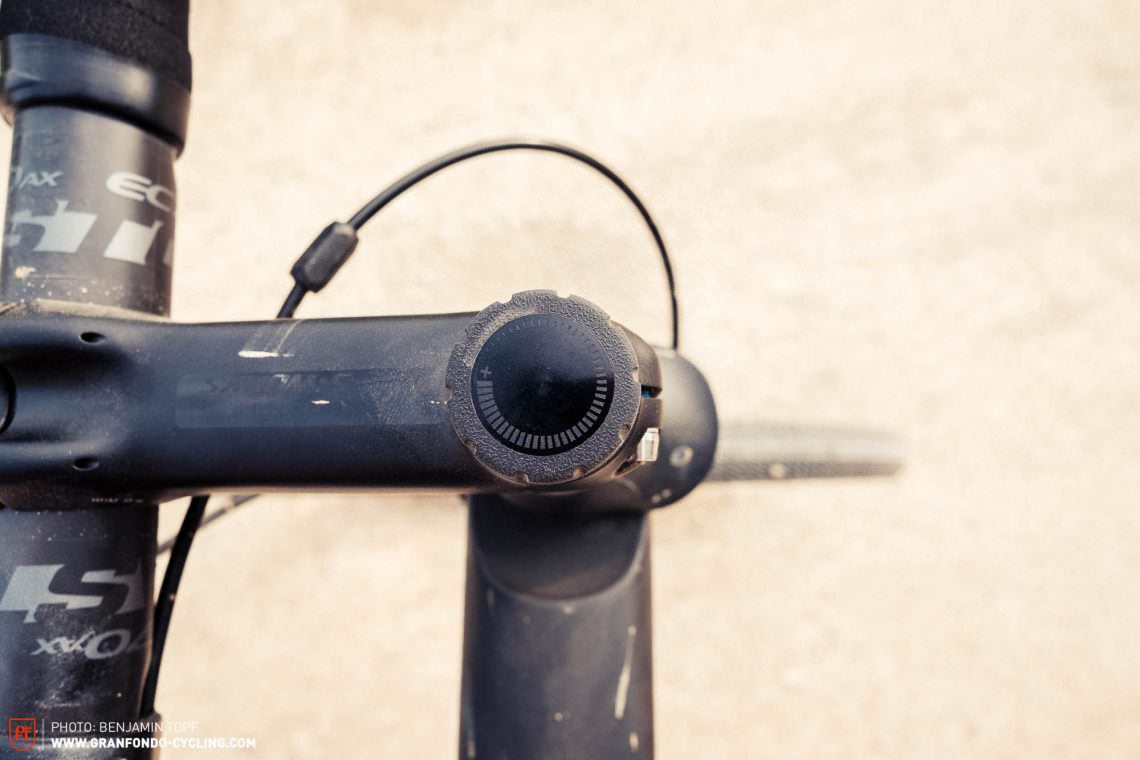
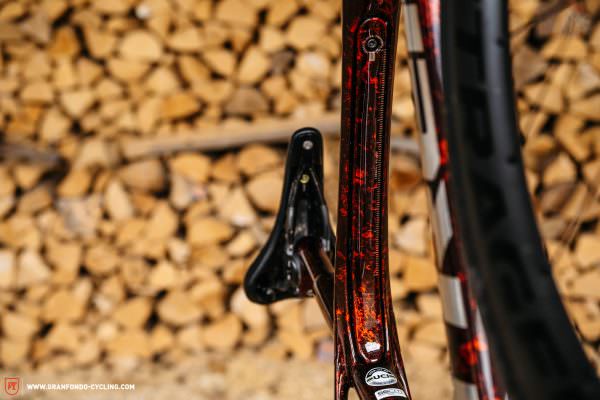
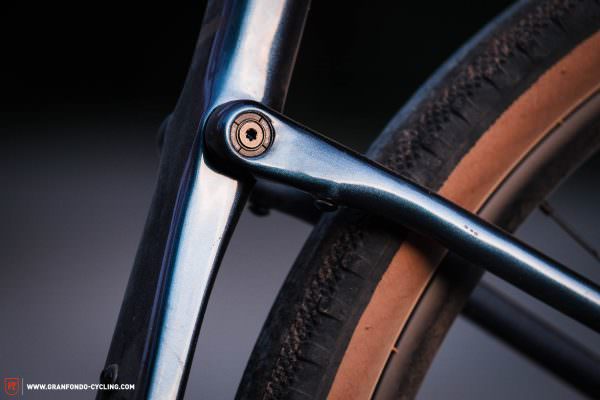

Gear and accessories for your gravel bike
Unfortunately, buying a gravel bike isn’t enough because without the right gear, a breakdown will mean the end of your ride. In addition to a multitool (group test available in our sister magazine ENDURO) and a mini pump (group test available in our sister magazine ENDURO), you should always carry a puncture repair kit and a spare tube when you ride. It’s best to stow all of this in a bag attached directly to your gravel bike. For an overview of suitable bags, have a look at our comprehensive bikepacking bag encyclopedia (available here).

Riding kit for your gravel bike
How does the saying go? There’s no bad weather, just the wrong clothing – there are no excuses to stay inside and laze around on the couch just because it’s rainy or cold. The selection of multifunctional clothing is almost endless and you’ll find an outfit to suit every preference. Whether you’re going to wear baggies or bibs on your gravel bike is completely up to you. Performance-oriented shoes with stiff carbon soles are just as welcome on a gravel bike as regular sneakers. That’s the nice thing about gravel: there are no rules, no limits, no labels and no barriers. The world of gravel is endless and always waiting to be explored! What are you waiting for?

Did you enjoy this article? If so, we would be stoked if you decide to support us with a monthly contribution. By becoming a supporter of GRAN FONDO, you will help secure a sustainable future for high-quality cycling journalism. Click here to learn more.
Words: Philipp Schwab, Andreas Maschke Photos: GRAN FONDO team







